-
Posts
758 -
Joined
-
Last visited
-
Days Won
16
Content Type
Profiles
Forums
Gallery
Posts posted by Singapore Reef Club
-
-
How to register SRC Forum Mobile. (IOS)
Hey Guys! Today I will be writing down a tutorial guide on how to register on Singapore Reef Club Forum and also how to use Tapatalk to access the forum on your mobile as an app.
Firstly that is few thing we need to understand.
SRC Forum is a standalone forum that require an account to post or access to full features.
Tapatalk is an app that is used on mobile devices that allows you to access all your online forums in one place. Once you install the app, you identify the sites on which you participate in forums (such as this one) and provide your login info to sign into the forums. Once signed in, you browse the forums and can post and reply to posts.
Therefore in order to use Tapatalk to access SRC, you need a total of two accounts, (one Tapatalk, one SRC).
*You can log in as guest, but your information might not be saved.
Here is the instruction on how to download tapatalk and register.
- Open your App store.
- Search Tapatalk and click download.
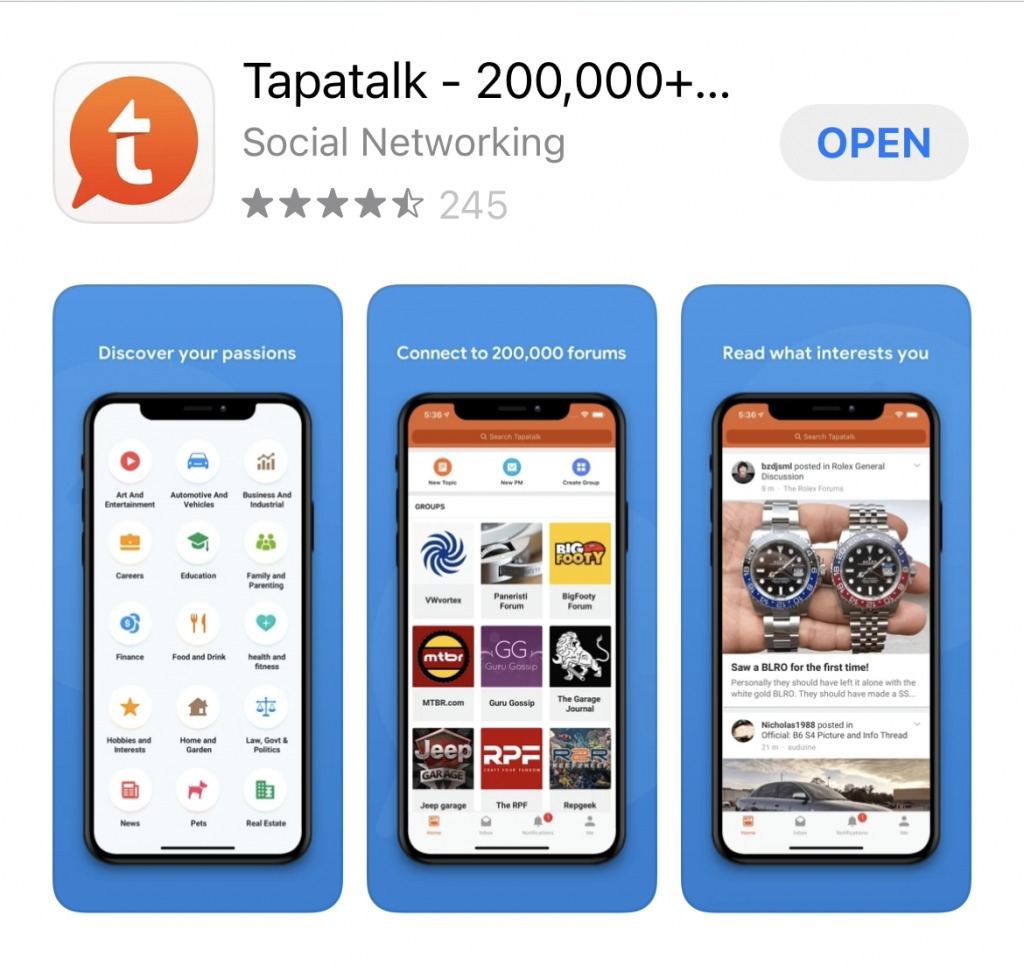
3. After installing, open the app and you will see this page.

4. Click GET STARTED.
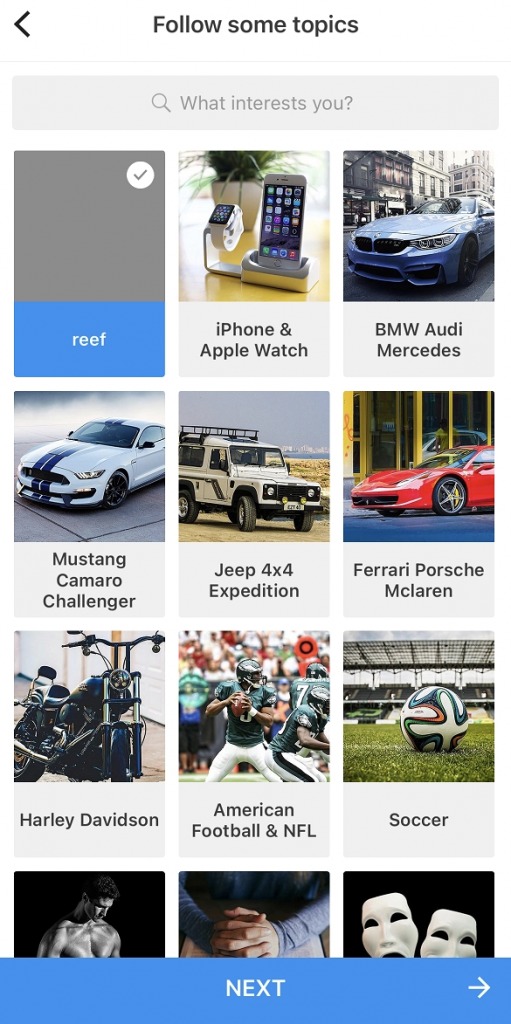
5. Click or search on anything you want to follow and click NEXT.

6. Select NOT NOW if you want to log in as a guest or you can create your own Tapatalk account (This is not the SRC Account).
If you click Sign Up it will bring you to this screen. Key in your desire username and password and click Continue.

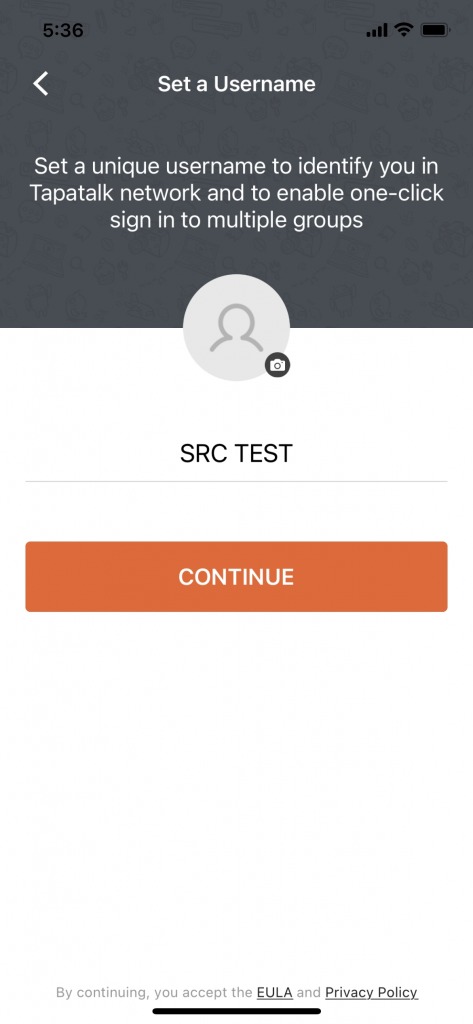
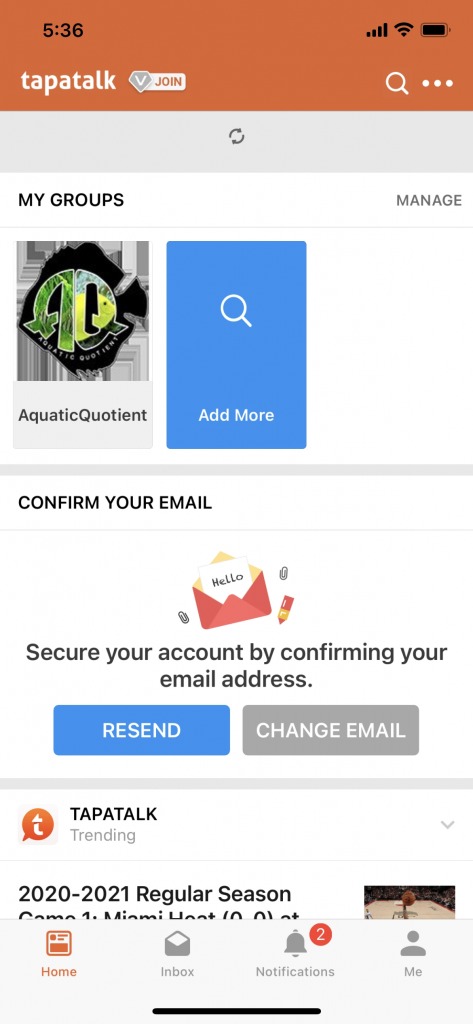
This is the homepage of Tapatalk. Now you need to search for Singapore Reef Club Forum. On the top right side click the magnifying glass and search Singapore Reef Club.
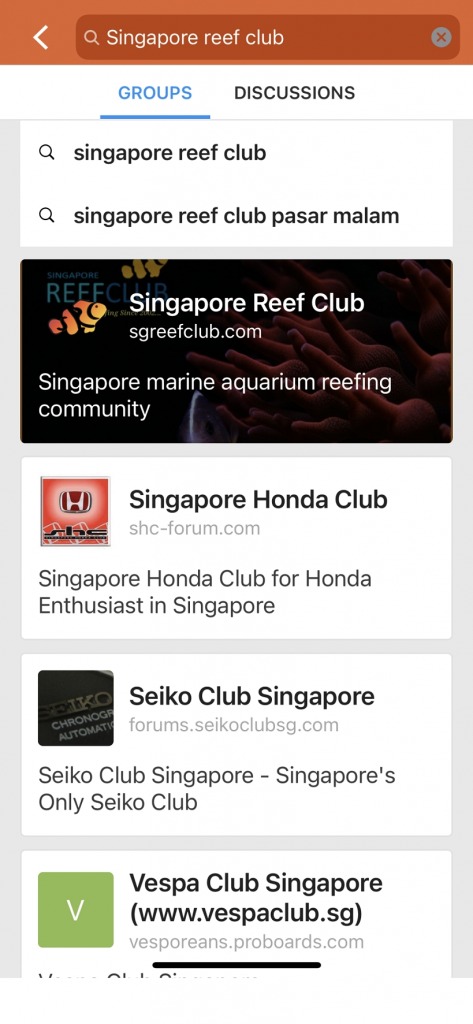
7. Click Singapore Reef Club and press follow.
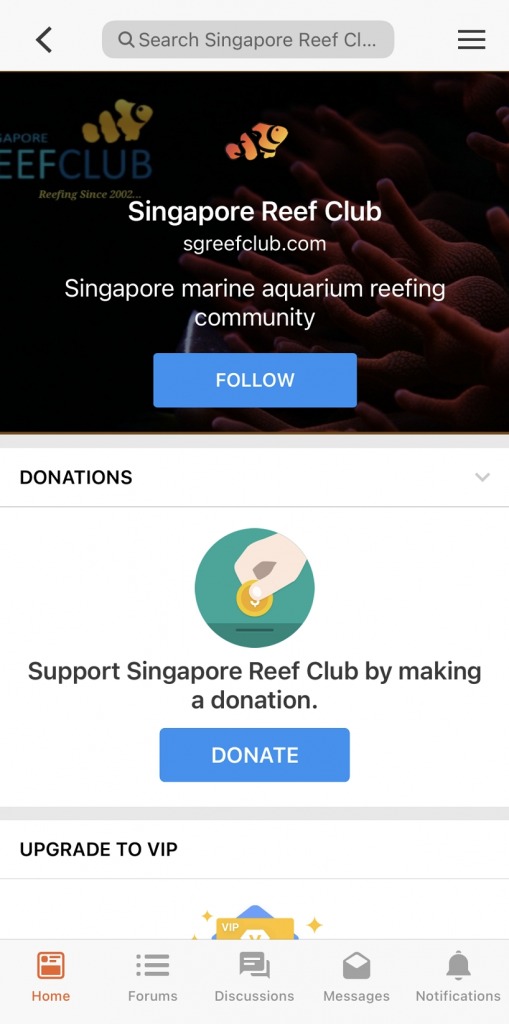
8. After you click follow, they will ask you to register or log in. This is where you must register an SRC Account to be able to post and access more features.
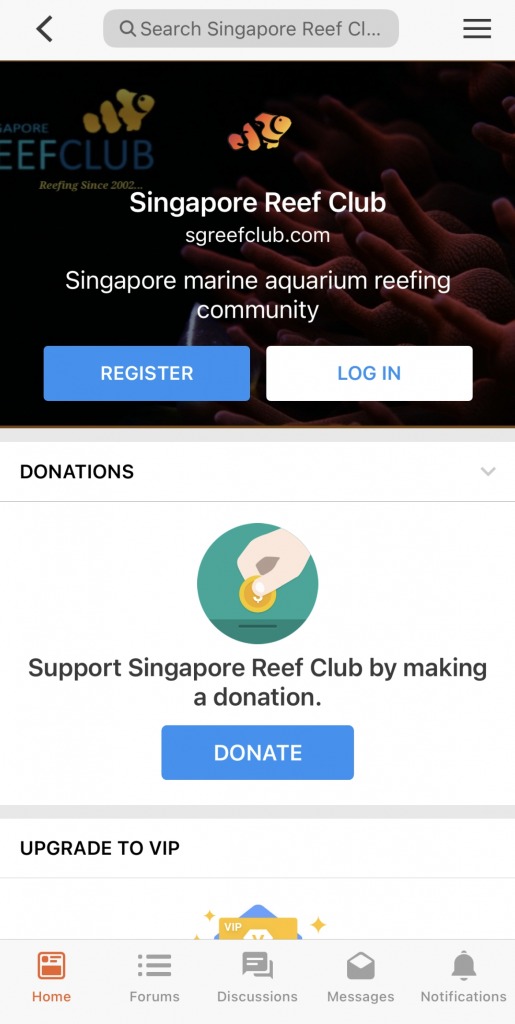
ALERT: Unfortunately you will not be able to register SRC Account through Tapatalk App. Just simply use your browser like Safari and register your account through the internet browser.
9. Open your browser and register your SRC Account through your browser. If you have an existing account, just skip to Step 12a.
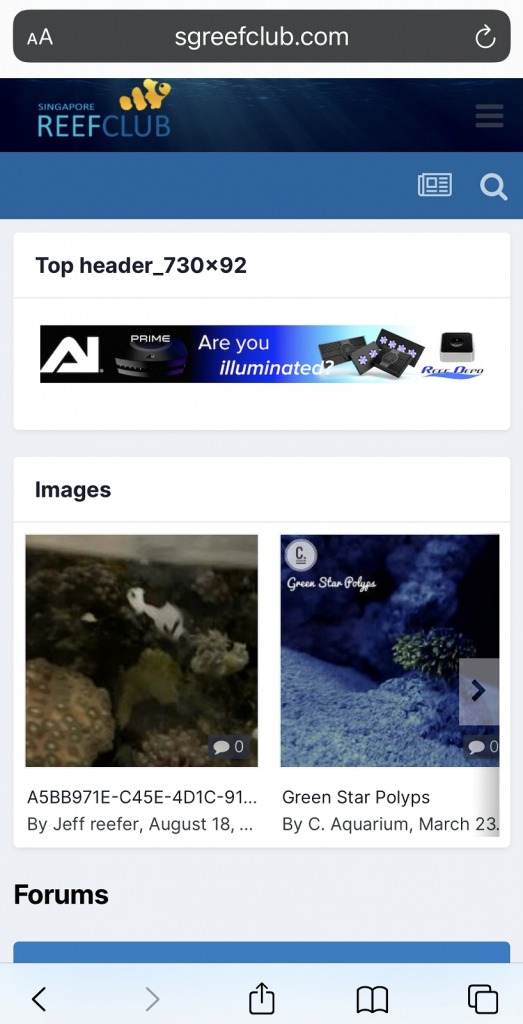
10. Click on the 3 Bars on the top right to Register/Sign Up which is shown on the next picture.
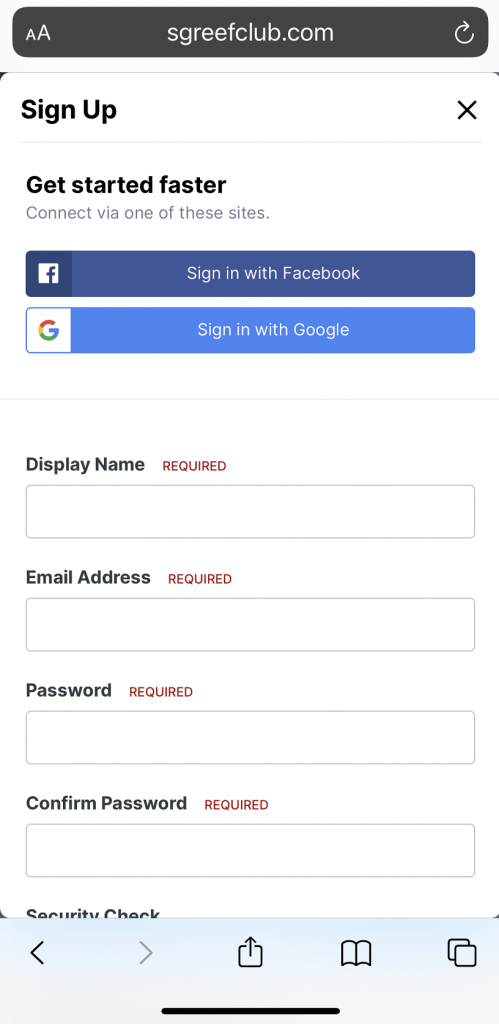
11a. You can link to your social media or manually key in your information for registration.

11b. Remember to click agree to the Terms of Use and Privacy Policy.
11c. After you done register, you are require to verify your email address to access to full features.
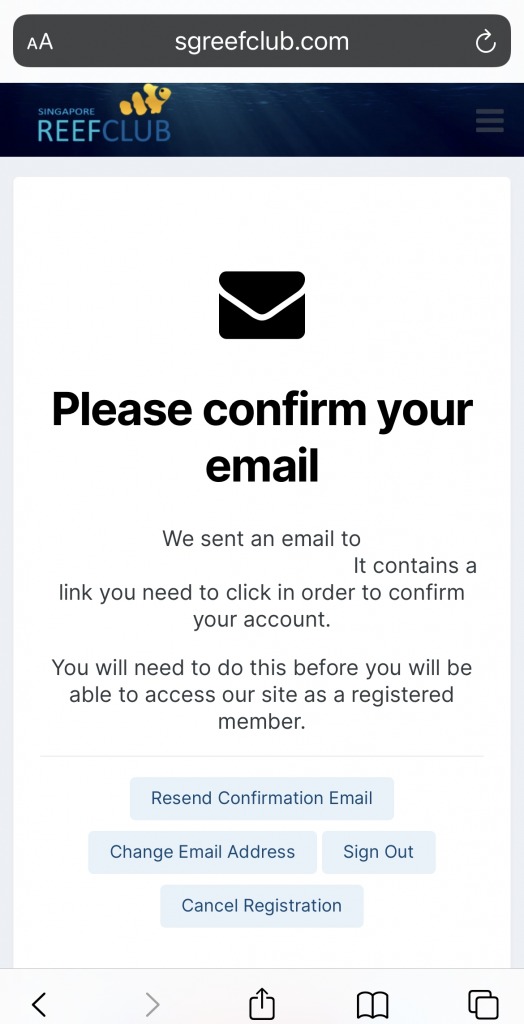
12a. Now all you need to do is switch back to your Tapatalk App and log in with your existing Singapore Reef Club Account.
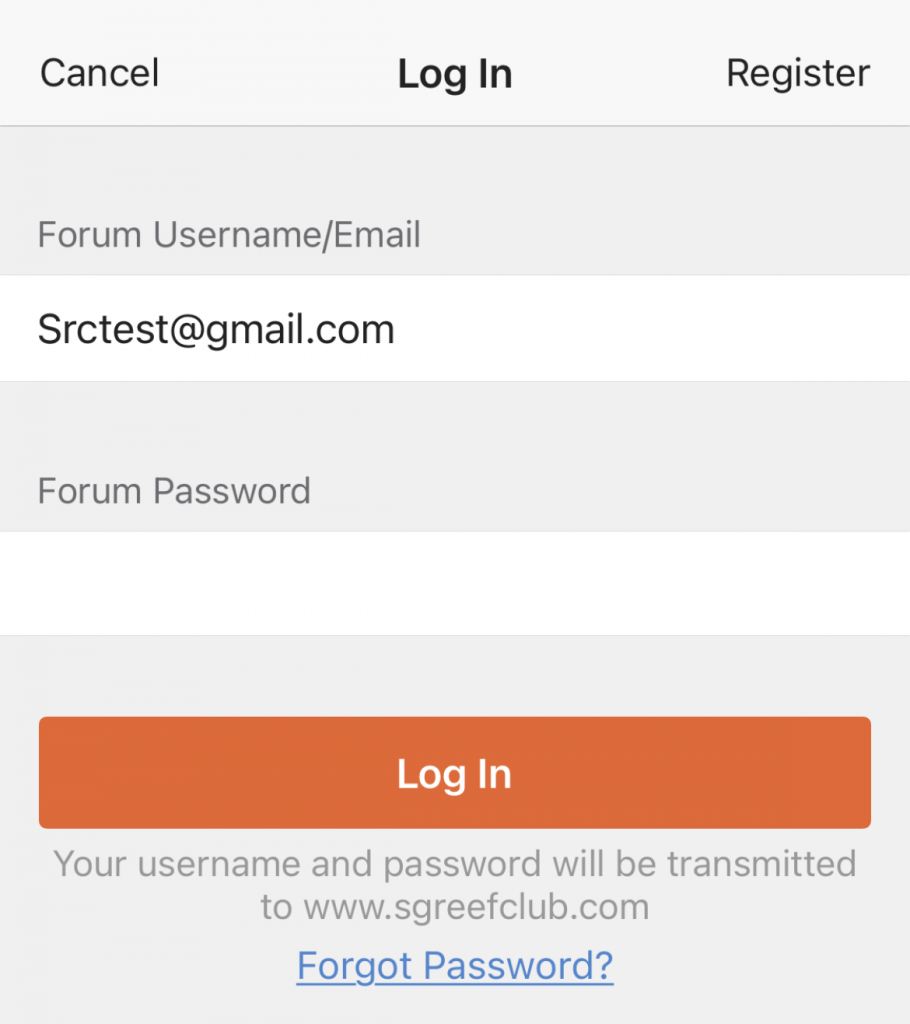
12b. You should be able to see the home page.
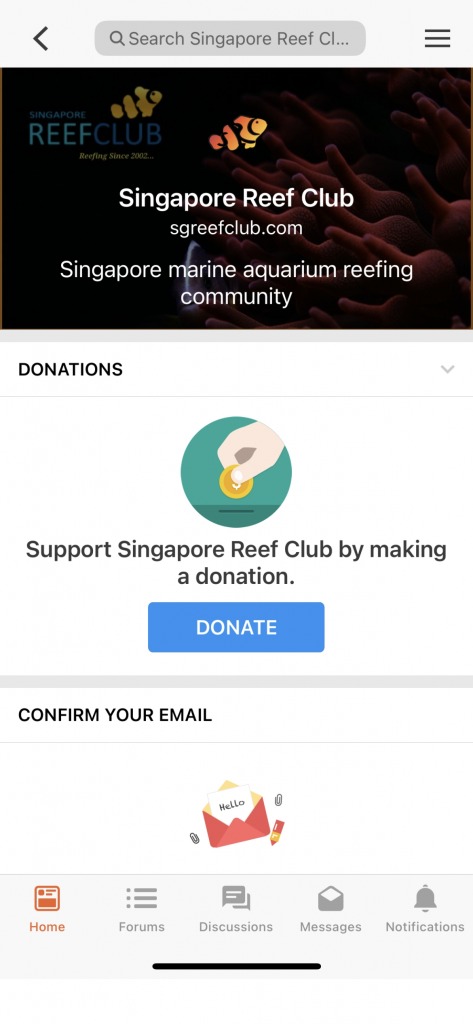
13. To know that you have successfully log in, just click on the 3 bar on the top right corner and you will see this photo shown below.
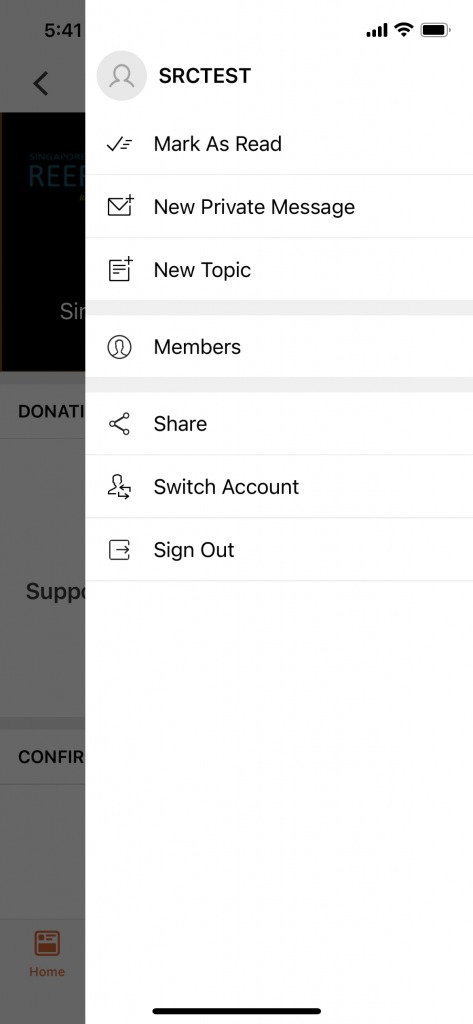
14. Congratulations! Welcome to Singapore Reef Club Forum.
In summary
- Tapatalk account and Singapore Reef Club Forum account are two different accounts.
- You can log in Tapatalk account as a guest to access to Singapore Reef Club Forum with App.
- You are required to register Singapore Reef Club Forum account through your browser as registering through Tapatalk doesn’t work.
Thank you for reading this article. Hope I am able to provide some help!
Author - @Willy Guccivera Yap
-
Protect yourself. Protect your tank.
Do you get rashes when doing tank maintenance? Are you susceptible to dermatitis or eczema since you started reefing?
This is a 2 part topic about wearing gloves when working on your tank. And about alternatives to using a bandage if you have an existing cut but need to touch tank water.
We need to be reminded that the home aquarium is filled with bacteria & toxins Some may have heard of mycobacterium marinum, an infection that produces skin lesions that is very difficult to treat in humans. Palytoxin is another highly toxic poison from zoanthids & palythoa. Mild symptoms include rashes & numbness. But severe cases can lead to kidney failure & coma.
Personally, I avoid putting my bare arms in the tank to minimize or even avoid transferring moisturizer & skin dirt into the tank.
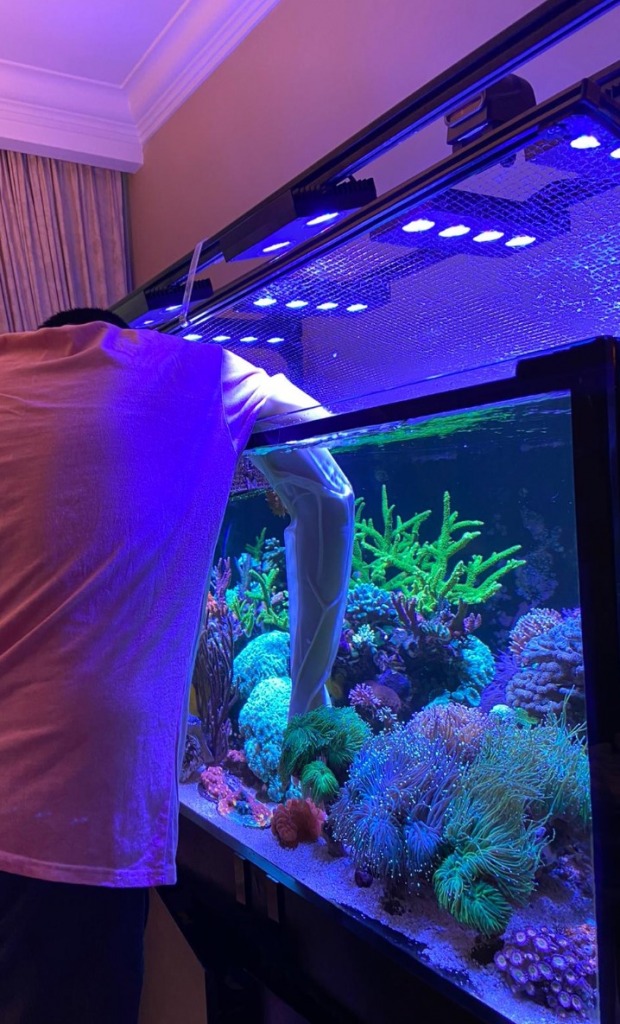
Avoid putting bare arm in the tank Most folks don’t bother with gloves. For many, it’s not an issue. This is what a dermatologist at National Skin Center said:
“When skin is healthy, it has many layers to protect us. But when the barrier is compromised, we lose that 1st layer of protection. Bacteria & toxins can enter our bodies causing rashes or in more severe cases, poisoning.
As we age, the surface layer of the skin (epidermis) thins out. Skin loses elastic tissue (elastin & collagen). Basically, it becomes more fragile as we age. This is an irreversible process.
Salt in particular is very dehydrating and accelerates the degeneration of one of the most important organs of the human body – skin.
Moisturize at least twice a day.
While steroid creams can heal eczema & rashes very quickly, it is not to be used long term. Steroids thin the skin (same effect as aging process). Similarly, this is irreversible. Thin skin breaks easily. “
In this article, I will share some thoughts on glove products used.
Disposable gloves are good options as most have a ‘tight fit’ – allowing you to feel what you are doing (e.g. Fragging corals or fixing equipment). If the gloves have a tendency to slide off, just use an elastic band or elastic Velcro strap (~20-30cm is good) to secure it.
Nitrile gloves are my preferred choice of material for reefing use. Nitrile is short for acrylonitrile-butadiene rubber. This synthetic material is notably more durable & resistant to chemicals. The ‘standard blue’ gloves are about SGD$12 for 100 gloves

Nitrile gloves come in different colours and thickness. Gloveworks for example are much thicker for added durability (to be used at workshops). Some have raised dimples for better grip. Prices vary.

I always disposable gloves when gluing corals – better to get glue on the glove than on your skin.
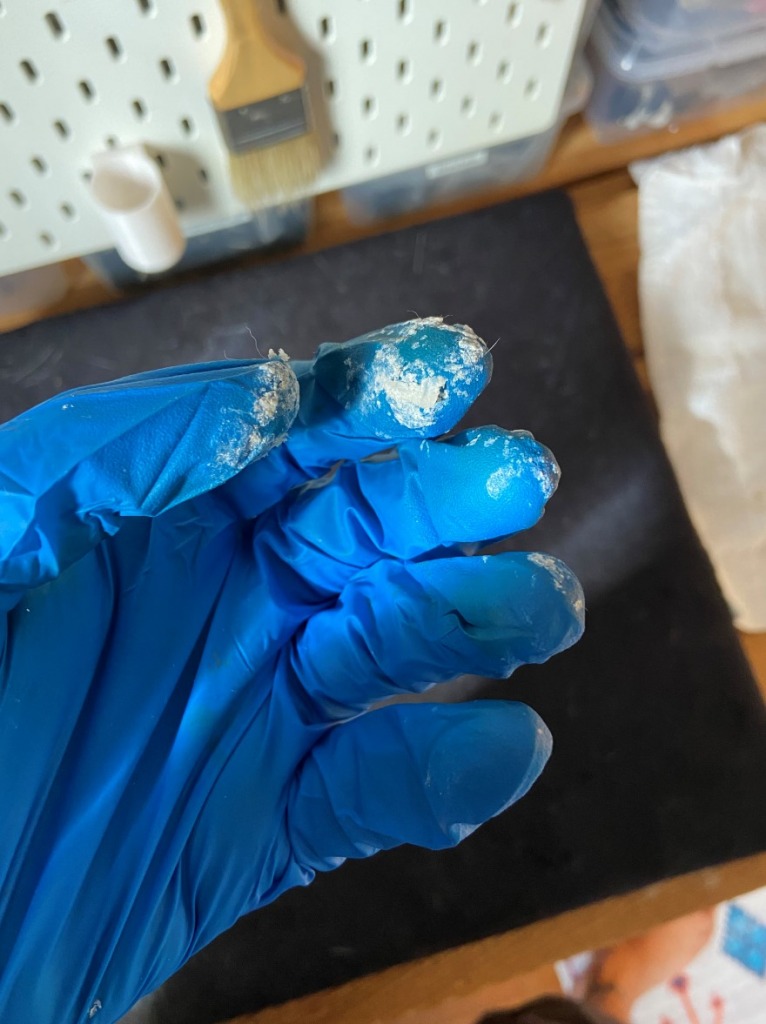
Vinyl gloves are made from PVC (a petroleum-based film). They are relatively cheap but less durable. Vinyl is less elastic than nitrile & latex, hence giving you a looser and more comfortable fit. I don’t like these for the hobby. Breaks too easily.
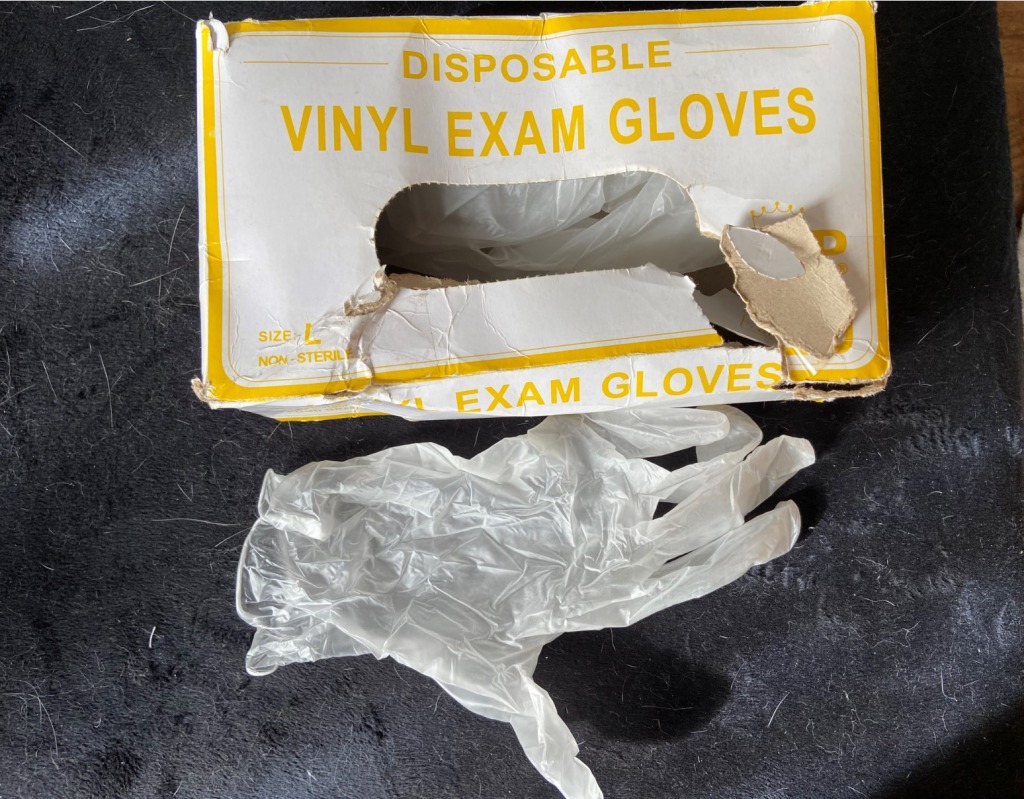
Polyethylene (PE) gloves are most common in the food industry (food safe). They are about 75% cheaper than nitrile gloves. But they are usually quite thin & break easily. PE gloves are generally loose fitting & not practical for handling frags.
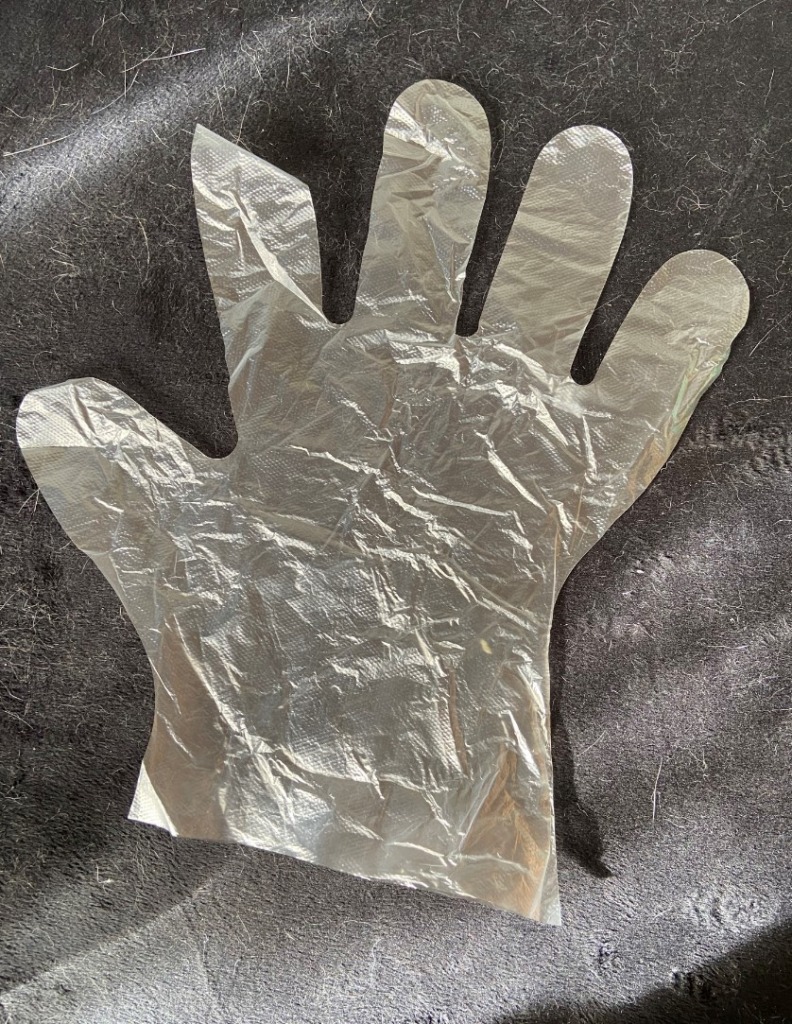
There are full length PE gloves (up to the armpit). These are good if you need to dip your arm into the tank. Look for the thicker variant for veterinary examination but note they still break quite easily.
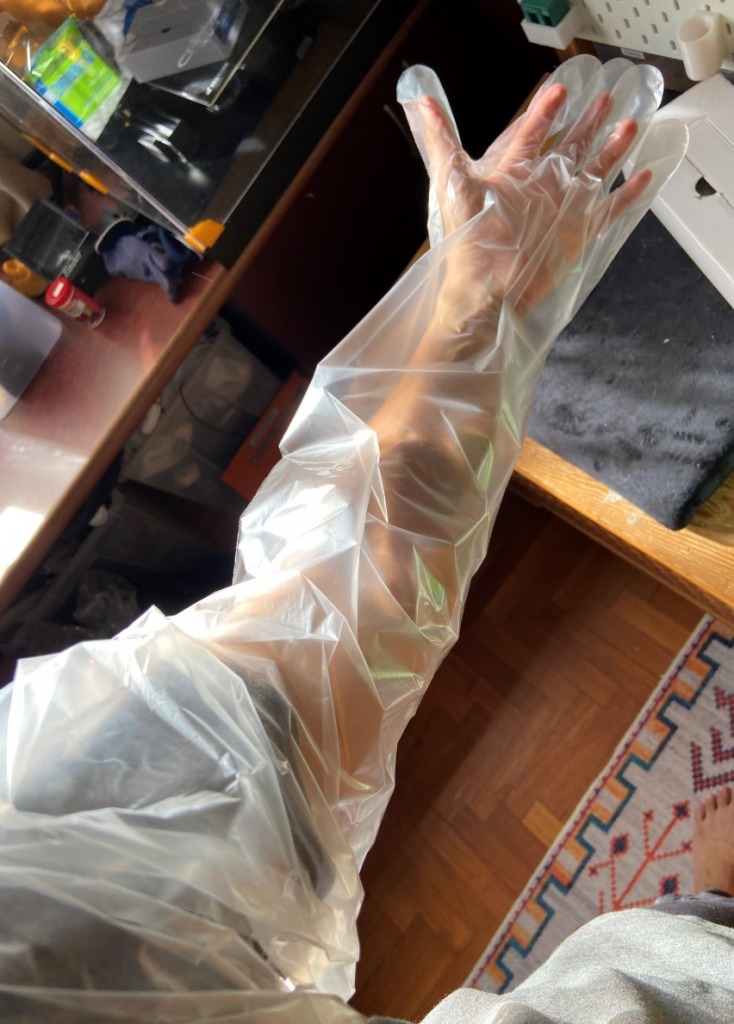
For non-disposable gloves, a good quality one is Kimberly Clark Nitrile glove (G80) The picture below is the variant that reaches the forearm. They have another version that reaches the elbow.

For more heavy duty and waterproof use, my favourite is the ATG MaxiDry. This is a nitrile coated glove. The palm side has a microfoam / non-slip grip. Its thick & very lasting. Snug enough to be able to use for fragging & gluing corals. There is a version that reaches the wrist (see pic). Good for general tank maintenance – mixing salt, washing wavemakers with acid. There is another version that reaches the forearm.

For full length non-disposable gloves, these PVC gloves are very thick & durable. You often see them used by fishmongers. But the main issue is they are a one size fits product where the finger section is very big. Combined with the thick coating, you won’t be able to feel anything when handling small & delicate items.

In general PVC gloves are not food safe. They tend to have a plasticky chemical smell.
These gloves were good for washing rocks & dipping them in vinegar. Now I’ve repurposed them for showering the house cats (and to protect my arms from their nails)

Full length latex gloves. I use these on a regular basis. These are aquarium specific and can be found at good LFS.

It fits the fingers fairly snug & goes all the way to the arm pits. The ends near the biceps are broad and may slip down, so just use an elastic band to secure it in place.
These gloves aren’t cheap. Take good care of them & they should last at least 6 months. As these are made of latex, some basic care is needed. Rinse off the latex powder before first use. Rinse the gloves with water or ideally with mild detergent, both inside & outside to prolong its life.
If there is a need to use them when gluing corals, just slip a nitrile glove over it to protect the more expensive glove.

I hope this article has been useful for you to down-select the right glove to get. In summary, the 3 must have are :
- Full length latex glove if you need to put your arm in the tank
- Nitrile disposable gloves for general use
- ATG Maxi dry for more heavy duty work
And the option to combine the above for your application.
Remedy for reefing related cut & wound injury
Liquid bandages
If you are using a normal bandage or plaster on an existing cut on your finger, you are likely to get it wet along the day (eg washing hands). On the other hand, waterproof plaster don’t seal all that well. Its worse if the plaster gets wet with tank water (risk of bacteria & toxins getting into the cut).
Liquid bandages are something I tried the past year which works quite well. An alternative worth considering.
WARNING : Do note the application process stings like crazy when the chemicals touch your raw wound.

The 2 commonly found in the local pharmacy are LiquiPlast & Betadine Clear Liquid Bandage.

Apply the 1st layer. Brace yourself (for the sting). Allow to dry.

After 2 coats – a reasonably flexible & strong protective film is formed.
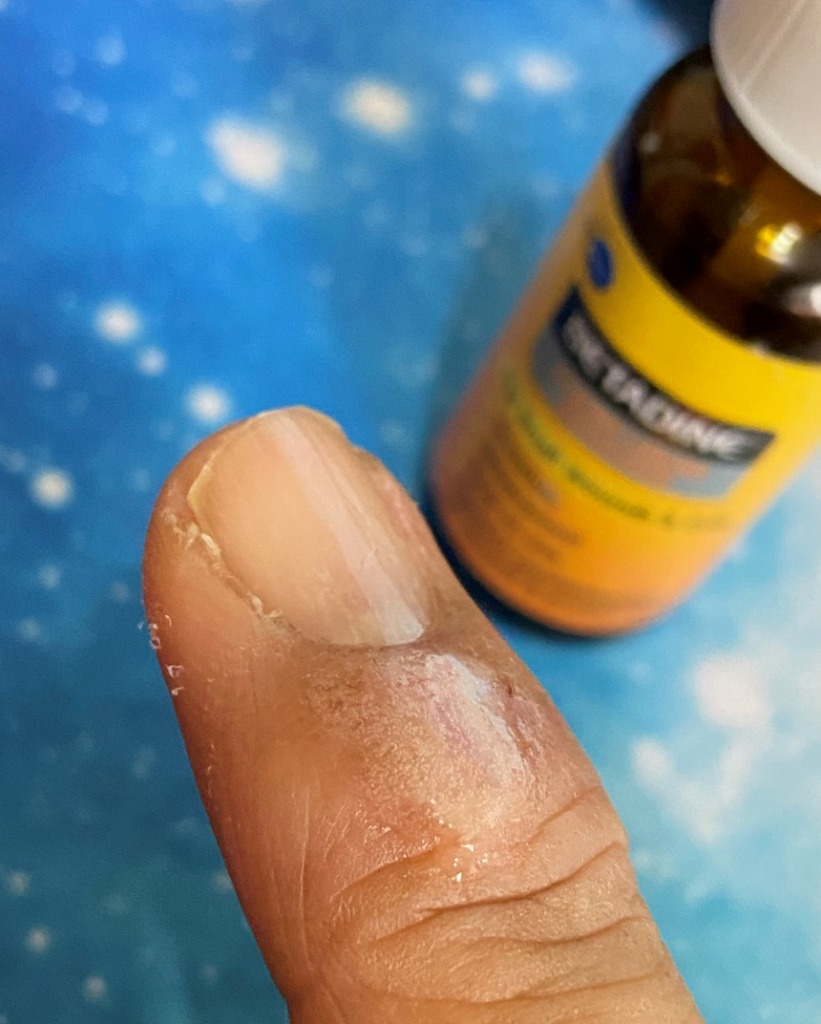
LiquidPlast seem to use more solvent. It adheres to the skin better but is more painful during application.
Betadine is more viscous & forms a thicker layer. It does not stick very well, so apply over a larger area. In general, both works well to give you the added protection from dirty tank water.
Have a happy & safe reefing week ahead.
Author - @SubzeroLT
-
Are you ready to start a Marine Tank?
As a newbie in the salty side of the hobby, you might have heard people telling you that starting a marine aquarium tank is relatively expensive compare to a freshwater tank and it is hard to upkeep it. If you ever have thoughts of starting a marine reef or fish only tank and not sure if you are able to do so, in this article I will share with you more insight, tips and possible worst scenario and solution for you to judge if you are ready for the saltwater journey.

Commitment
Be it setting up a freshwater or saltwater tank, everything will always start with the level of commitment that you are willing to take. Are you be ready to take care of your new found hobby? What is the comfortable tank size that you are able to upkeep and maintenance on your own ? If not, are you be willing to pay someone to do it for you ?
So what is like doing your own maintenance?
Regular Maintenance usually consists of replacement, cleaning of the filter wool, conducting water parameter testing to ensure that all parameter is in check especially if you are keeping a coral tank, also ensuring that your fish are well fed with proper nutritional foods. If any of the elements is found to be out of range or imbalance during your routine water testing, you would need to adjust your daily dosing or supplement it to ensure it stay on the optimal level.
What other preparation do I need to start a marine tank? I will break down most of them below.
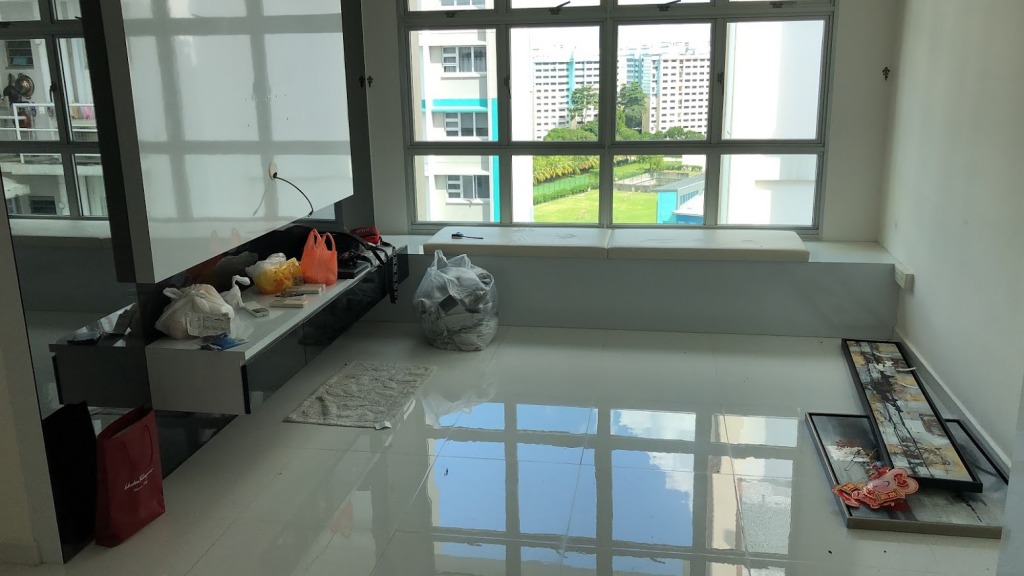
Will you able to find space to build a tank?
Space / planning
We are talking about the place and space that you are going to need and location where you are going to place your new tank. Are you planning to keep a reef aquarium or a FOWLR ( Fish Only With Live Rocks) or even a species only setup which could be seahorse tank, jellyfish tank etc.. Do you want a ready make tank or go for a customise setup ? How big of a tank do you want to have? What kind of fish do you want to keep? Knowing and planing these beforehand is important as not only it helps in your budget planning, it also determines the types of equipment that you would require later on.
If you do intend to set up a fish only tank, what types of fishes do you intend to keep? For example, fishes like the tang family will require a tank size of more than 3ft to have plenty of space for it to swim around. If you intend to start small and upgrade to a bigger tank later, do you have space for another tank when your corals and fishes grow bigger?
This ain’t a goldfish in a fishbowl nor a goldfish can do well just in a fishbowl.
Not sure about the fish compatibility and what fishes that you can keep? You can always ask around in the discussion community by starting a new thread in the forum or check out our marine fish database knowing what you will be getting.
Cost / Budget
The marine aquarium itself isn’t really an expensive hobby if know what you are getting. Especially so if you’re not chasing popular names of corals or chasing expensive fishes, which could be even more affordable compared to some of the freshwater fishes.
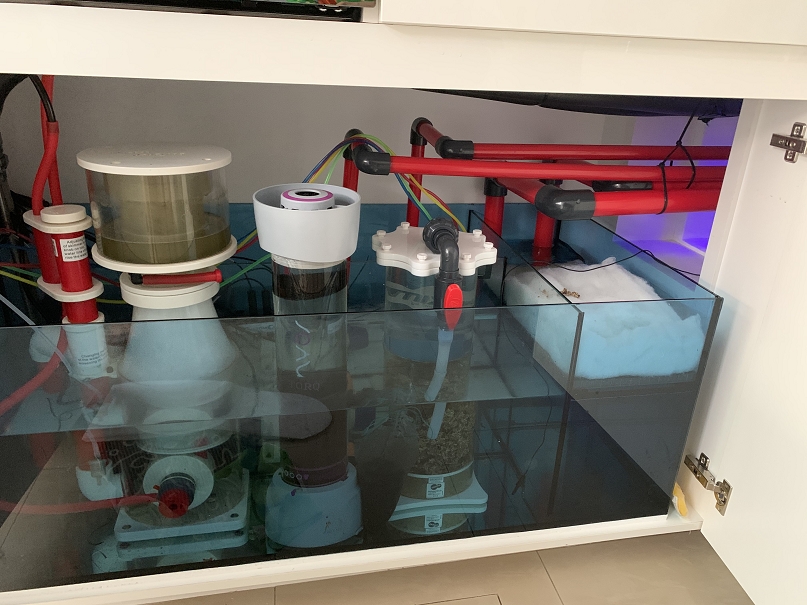
A common marine tank sump setup with equipment like reactor, skimmer and chiller.
It is always debatable that equipment should always buy oversize which will affect your overall budget, however, it might not be necessary so depending on your bioload and what do you intend to keep as well, as it makes no sense to buy an oversize skimmer if you only have a few fishes or corals in your tank.
So how much do i need to spend?
It is advisable to check for quotation from a few tank maker and do some research online as well as our forum, or our saltwater hobby group to check and ask around what equipment suits your budget. After setting up the initial budget for the basic equipment and tank setup, do prepare to budget for your fish stock list as well as some basic supplement like for example, bacteria to start your tank cycling and maintenance aspect of it.
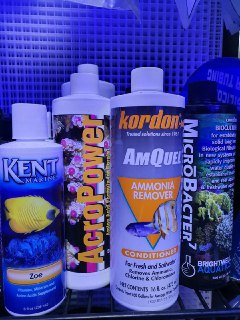
Some of the common and basic supplement used in a marine tank.
The last aspect would just be stocking up on your new tank, waiting for your favourite fish / coral to come along in one of the shipments from the local fish store. Not sure when the fish is coming? You can always subscribe to our telegram shipment broadcast channel HERE to be the first to know.
Knowledge
Knowledge is Power – As a beginner in this hobby, the salty side of the setup might be new or alien to you. Even if you browse or search online which is full of resource, stubborn people like me tends to experience hardship, paying endless school fees before being reliase that being stubborn is actually wrong ! And start to listen to experience reefer in this hobby what they shared is actually true ! (That is why I am writing this now).
If you happen to read this article, Good. Please take our advice on what the experienced hobbyist share with you on the forum .
Conclusion
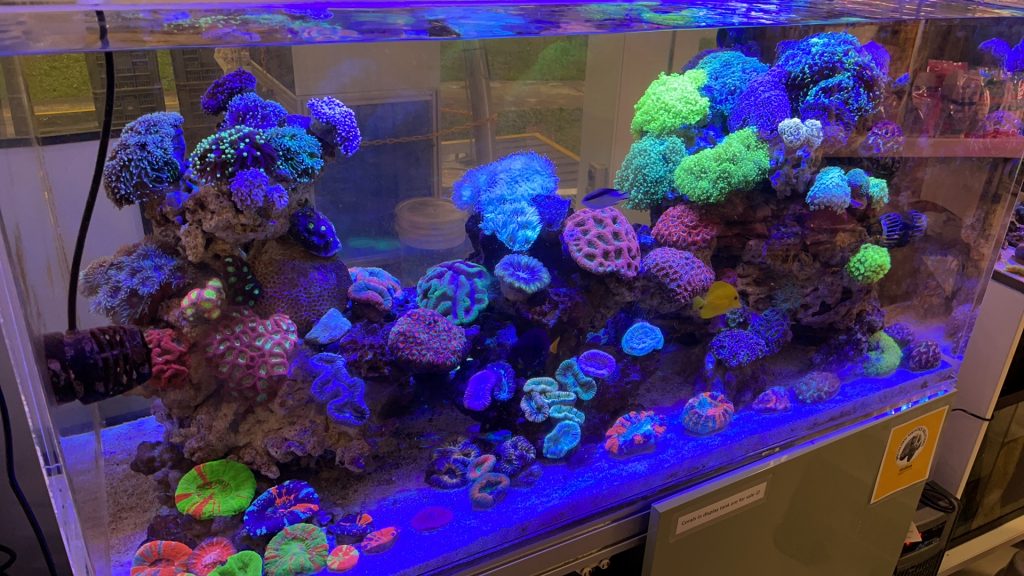
A coral reef display tank at one of the local fish store.
Although this might be a short and brief article regarding the new tank setup, I hope this article would be able to assist new hobbyist that is jumping into the salty side of the aquarium to have some basic information and knowledge what you are in for. Yes, Reefing could be slightly more tedious as compared to setting up a freshwater tank but the reward of it is a beautiful and colourful coral and marine fishes that a freshwater tank cannot compare to. When you step into the marine hobby, you will also be able to learn more about water chemistry and the important aspect of it and start to appreciate the uniqueness of the marine life in our mother ocean.
Starting a marine tank do required patient, knowledge and discipline but it will reward you with the best ever master pcs of an ocean in your own space.
Thank you for reading.
Author - @Willy Guccivera Yap
-
Green Sinularia Leather coral
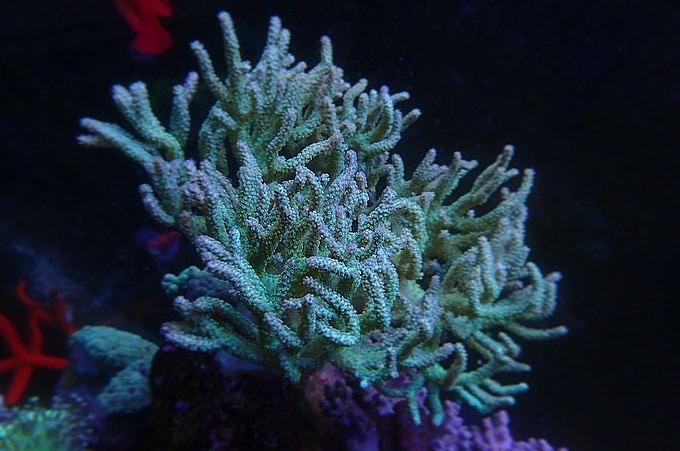
Sinularia is a common type of finger leather coral that has vibrant bright green colors that is a great addition to any reef tank that is often neglected by many hobbyists.
As the name suggested, finger leather, the growth of its branches are like a tiny finger spreading upwards. Sinularia has polyps on the surface of it branches and that is how it reach out for food particles from the water column.
The good thing is leather corals are photosynthetic which means they will get most of their energy from just photosynthesis. You don’t have to direct feed!
As time goes by, it tends to close its polyps and has a shiny smooth skin surface. Fraid not, as long there’s flow it will help the leather to shred its skin.
They are also known to be hardy but I kept mine under this parameter and is doing very well.
- No3 10PPM
- Po4 0.25
- Calcium 450
- MG 1350
- KH 8
- PH 8
- 1.025 Salinity
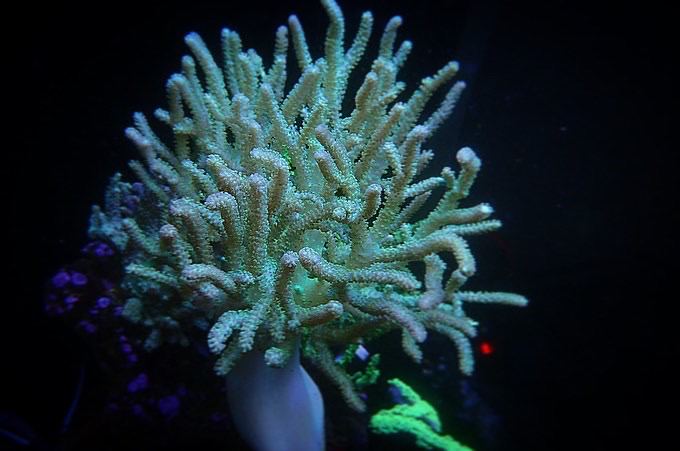
In my experiences they tend to be more luminous under strong par as the light will expel the Zooxanthellae in them BUT do not have too strong light or direct focus light on them as it will bleach the leather turning it to white or might even cause it to die from stress due to prolong strong lighting.
However, I notice that they tend to do better under medium flow than high flow, as it seems like they will not have pressure from the flow and able to expand and grow faster.
Leathers are also easy to propagate by propagating with either sharp scissors or knife and leave their branches to settle down on a low-flow area with rubble at the bottom that help it to heal itself and attached to the new ruddle.
Another common method for securing the leather coral is by using a rubble band to secure it to a liverock until it encrusted or tieing a fishing line over it. (In the future I’ll do a video on it!)

Photo Credit to Iwarna
Thanks to Iwarna Aquafarm, I’m able to shop from my home to have Auzzie Sinularia deliver to me.
You can visit them below:
Aquarium Iwarna Pte Ltd
70 Pasir Ris Farmway 3, Singapore 518234
https://goo.gl/maps/CX6FAyS6vNVmXg7G8
That is it for this article. There are still so many beautiful soft coral to collect for. So watch out this blog space for me to share with you this amazing corals!
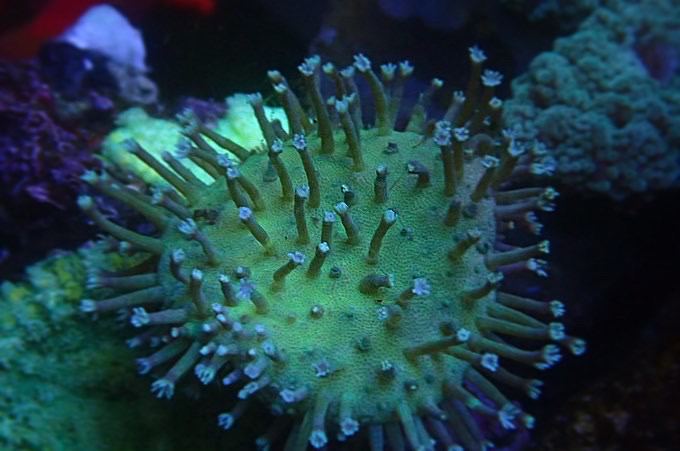
Beautiful Toadstool that is also another kind of leather coral.
Author - @Willy Guccivera Yap
-
Nutrients on the Reef (I)
Sooner or later, aquarists will encounter the topic of reef nutrient when keeping an aquarium. Many aquarists are often concerned about these questions:
- Is my nitrate and phosphate level ok?
- Should I feed my corals more?
- How do I reduce nitrate? or phosphate?
All these are fair questions.
However, if we approach reef nutrients just by looking at the nitrate and phosphate levels from test kits. We are like a blind man touching an elephant. For we only see a small part of a great picture.
For this article, N and P refers to inorganic salts containing nitrogen and phosphorus elements. We will discuss about how an aquarist can reduce nutrient level in a reef aquarium, just like how a driver steps on the brakes to slow down a car
Fixed vs. Free Nutrient

Queen Angelfish (https://upload.wikimedia.org/wikipedia/commons/thumb/f/f3/Holacanthus_ciliaris_10.jpg/1280px-Holacanthus_ciliaris_10.jpg) Let us consider a fully grown queen angelfish (H. Ciliaris). Show size queen angelfish is a foot long fish weighing almost a kilogram. For a fish of this size, it contains large amount of nitrogen and phosphorus in its body. However, when you add this beautiful fish into your aquarium, the nitrate and phosphate does not rocket through the roof. Why? It is because the nutrients are fixed in the tissue of the fish. Therefore these nutrients are not available for other organisms, such as bacteria and algae.

Pellets are a staple food for many captive fish Let us look at pellets then. When we toss a handful of pellets in to the aquarium, does the nitrate and phosphate increases? Maybe. When the pellets is freshly added, the nitrogen and phosphorus are “locked” in the pellet ingredients. When a fish eats the pellet, it digest it, and some of the nutrients become part of the fish. These portion of pellets does not increase the free nutrient of the aquarium. The uneaten and indigestible part of the food, however, will breakdown thanks to the bacteria in the water. This will increase the free nutrient in the aquarium. Thus overfeeding (define as feeding more than fish can consume), and feeding low quality food (contain much ingredients, especially terrestrial origin, which can’t be digested by the fish) are the two main reasons of out-of-control nutrition levels.

The much feared algae: Bryopsis (By B.navez – Own work, CC BY-SA 3.0, https://commons.wikimedia.org/w/index.php?curid=9364885) Let us last consider algae. A bunch of hair algae contains fixed N and P in its cell. if these algae dies due to medication or water quality. These N and P will be released, and the free nutrients in the water increases. Without intervention, theses free nutrients will likely encourage the growth of some other forms of undesirable algae or bacteria.
Test kit and Expectations
High nutrient or low nutrient? We often take reference not from the nature, but from the test kit we use. Take for example, nitrate. natural reef water has a nitrate level around 0.25 ppm. Based on this standard, we may consider 1 ppm nitrate as high, while 0.05 ppm nitrate as low. However, reefers generally consider 1 ppm nitrate to be rather low. This is because many popular test kits, such the Salifert nitrate kit, has a lowest reading of 2 ppm in their normal test mode.
Things are not much better when it comes to phosphates. Most test kits are not able to measure the level in the natural reef. The worst challenge, however, is that hobby test kits only measures inorganic phosphates. While there are plenty of organic phosphates in the water. For an aquarium with 0 ppm phosphate from Hanna test, it may have significant organic phosphate in the water. These organic phosphates supplies nutrient to cyanobacteria and dinoflagellate alike.
When it comes to organic carbon, well, welcome to the jungle. There are few organic carbon test kits in the market. Not to mention the desired level of carbon is, for a lack of better word, undecided. We don’t care so much about organic carbons because we can’t test it. What if this is the key to reef nutrient management?
C-N-P and the Redfield Ratio
Redfield Ratio
It is only reasonable that aquarist talk about nitrates and phosphates when talking about nutrients in a reef aquarium. After all, the only accessible test kits for our hobby is nitrate and phosphate. The inconvenient truth is, if we cannot test certain things, doesn’t mean it’s not there, or it’s unimportant.

Alfred C. Redfield In 1934, oceanographer Alfred Redfield went around and sampled the marine phytoplankton and deeper ocean water. When he examined the chemical composition of these samples, he discovered something interesting. The ratio of C-N-P, as well as other elements, are more or less the same. On average, the ratio is 106:16:1 in terms of the number of atoms of C:N:P. Since then, Redfield ratio is one key idea for oceanography studies.
In Aquarium
Does Redfield ratio applies to our reef aquarium? Yes and no.
Unless you aquarium is a bowl of highly concentrated phytoplankton, or a void consist of deep seawater, the Redfield is not directly relevant for the water parameter. In fact, most of our reef aquarium supports far less phytoplankton than natural reef waters. Therefore, fixating on a magic ratio is generally counter-productive.
However, Redfield ratio gives us some hint about nutrients. The C:N:P ratio is a fixed value for a given organism. For example, Chaetomorpha has fixed C:N:P ratio. Nitrosomonas has a different fixed C:N:P ratio. Green Hair algae, cyanobacteria, diatoms… each of them has a fixed ratio of C:N:P.

Diatoms, which have different ratio of C:N:P to, say, hair algae. (By Damián H. Zanette – Originally uploaded 01:59, 16 July 2008 (UTC) by Dhzanette (talk) to en:Wikipedia (log).(Original text: I created this work entirely by myself.), Public Domain, https://commons.wikimedia.org/w/index.php?curid=7267563) Therefore, if your aquarium relies on these organisms for export, then we need to supplies them with a good balance of C:N:P. For instance, we harvest chaetomorpha to export nutrients. The carbon is supplied when the algae photosynthesizes. In order to grow, chaeto takes up N and P from the water, thus export thing them. If the concentration of N in water is not sufficient to support the growth, the chaeto will not be able to take up any P as well.
The lesson from Redfield ratio is simply: organisms exports nutrients in a fixed ratio. If one nutrient is insufficient, they can’t export other nutrients either.
Exporting by Biomass
Why do we need to care about the nutrient ratio for algae and bacteria? This is because most of the aquarium relies on exporting biomass for nutrient management.
Bio-fixation
A fish contains a lot of phosphate. However, adding a powder blue tang into an aquarium does not release these phosphates into the water. The phosphates are “fixed” within the fish. It’s not dissolved in the water. The algae cannot make use of these phosphates to grow. Basically, these phosphates does not contribute to the available nutrient in your reef tank.
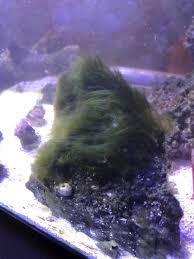
You are looking a a picture of efficient nutrient export (Reef2Reef forum) If we can grow organisms which takes up nutrients in the water column; fix the nutrient in its cells. Then we remove some of these organism from the aquarium. Voilà, the nutrients are exported. The more these organism grows, the more nutrients they remove from the water. In practice, there are many different approaches to achieve this.
Bacteria and Skimming
Like it or not, bacteria is the most numerous organism in your reef tank. In the most ideal condition, bacteria undergo binary fission. During the process, one bacterium becomes two, two become four. Before you know it, the amount of bacteria can reach unreal proportions. For instance, nitrosomonas, one of the common nitrifying bacteria, has a growth rate of 3.0/day. If your aquarium starts with a single bacteria, theoretically, there will be 205,891,132,094,649 bacteria one month later. This amount of bacteria would weight more than 200 kg. Fortunately for us, such situation is next to impossible in our reef aquarium. There is limited space and nutrient to support exponential growth. In addition, some bacteria dies off, or become prey to other organisms. Nevertheless, this growth of bacteria can significantly deplete the nutrient in the reef, and cause cloudiness at the same time.
Since the reef aquarium can only support a limited population of bacteria, nutrient export is inefficient unless the bacteria is constantly removed from the aquarium. Lucky for us, bacteria tends to flock together. This bacteria flocks are easily removed with protein skimming.
Algae as a form of nutrient reduction
Growing algae outside the display tank is a natural and effective way for nutrient reduction. Aquarists can grow turf algae within an algae scrubber. Alternatively, they can grow macroalgae in a refugium, or more recently, a reactor. Algae, being slightly more complex than bacteria, grows and propagates much slower. Therefore it takes longer for an algae based export to be up and running at full capacity.
Algae make the required organic carbon mainly from photosynthesis. However, different algae contains different proportions of N and P; and these inorganic nutrients must be take up from the free nutrients in the water column. This tiny detail is significant, because it affects the efficiency of an algae scrubber or macroalgae refugium.
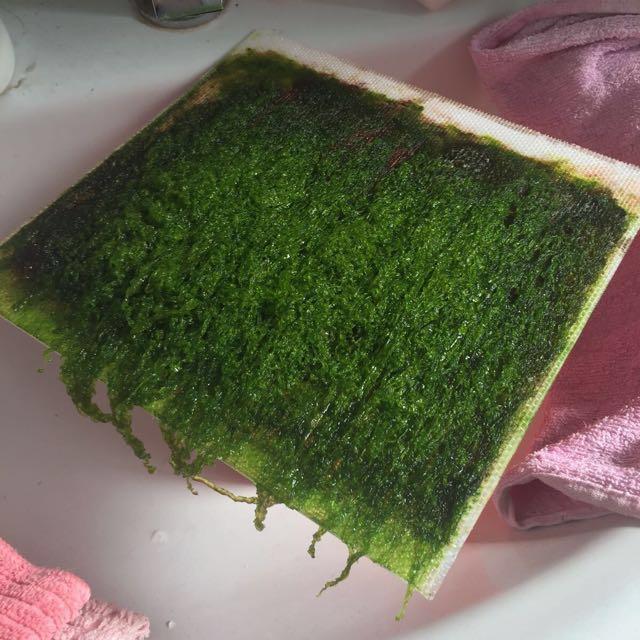
Algae Turf Scrubber
(image from carousell)In an algae scrubber, the aquarist does not purposefully keep a (few) species of algae. Many different algae species compete with each other based on available nutrients and space. When the phosphate is higher, for example, more brown algae will grow. In a way, an algae scrubber is effective across a wide range of water parameters, and it is self-tuning to a certain extend.
In a macroalgae refugium, the aquarist has to provide proper nutrients for the chosen species of algae. If a species of algae use up most nitrate in the water, but leave behind a lot of phosphates, then the aquarist needs to intervene to maintain the balance.
If an aquarist pulls some algae from refugium, and feed them to the fishes, are they exporting nutrients? Please let me know your thoughts in the comment below.
Corals
Corals, as well as photosynthetic invertebrate such as tridacna clams, requires N and P to grow. Therefore by growing these desirable organisms, aquarists unknowing remove some of the nutrients from the water column as well.
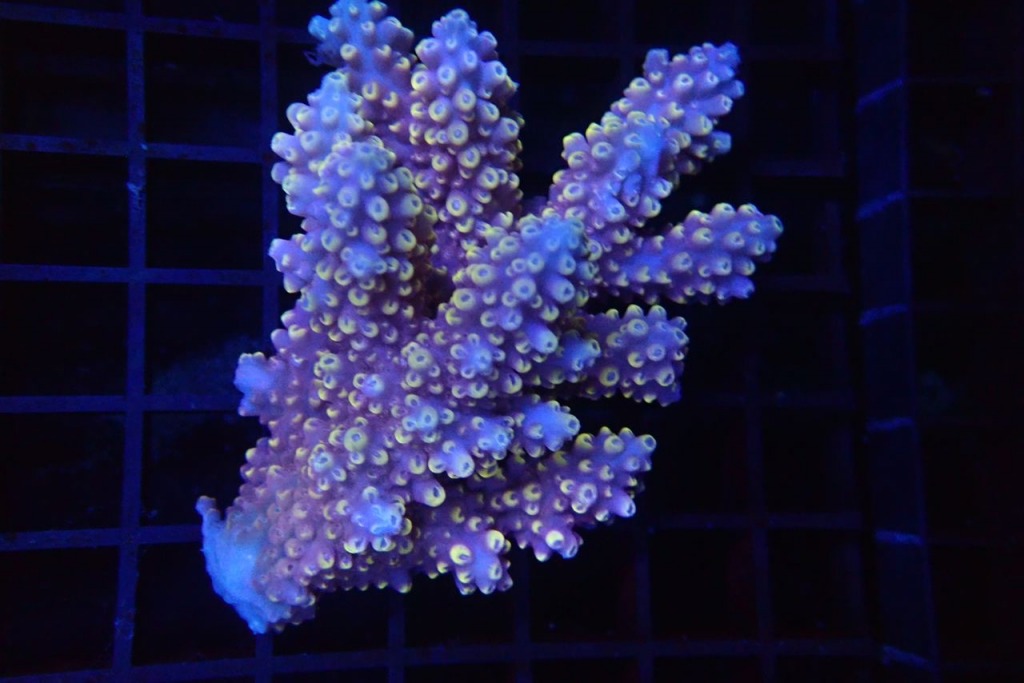
Since growing corals and invertebrates is the main goal of a reefer, this export technique is almost perfect. The problem however, is that the corals and inverts are more advanced than algae and bacteria. Therefore they grow slower, and also demand a more exacting water quality.
Managing Nutrient Imbalances
The methods listed above exports C-N-P at the same time. What can we do when the nutrients become out of balance? There are two tools in our arsenal: we can add in the limiting nutrients, or we can export the excess.
When it comes to addition, carbon dosing is extremely effective to provide the limiting nutrient for these bacteria: organic carbons. Addition of organic carbons directly into reef waters allows faster growth of bacteria, This, coupled with an efficient skimmer, can be very effective to export large amount of N and P. In some aquaria, when N and P becomes imbalanced, the aquarist can dose nitrate or phosphate to make up the difference, and eventually achieving a lower level for both N and P.
Selective export method; for N and P gives aquarist fine tuning ability to adjust the level of specific nutrients. Sulfur denitrator removes nitrate from the aquarium without affecting the phosphate level. On the other hand, phosphate media such as GFO and aluminum oxide takes care of phosphates without changing the nitrate level.
Conclusion and More
I start discussion from the perspective of nutrient removal, because achieving low nutrient level is the goal of many reefer. However, just like you need both accelerator and brake to drive a car, reefers need to know how to increase the nutrition in the water. Remember, the goal of reefing is not to get nutrients as low as possible, but to provide correct and stable level of nutrient based on how your aquarium is run.
In part II of this article, I would discuss the flip side of the coin. we will look at how we can increase nutrients in the reef in a controlled way. Meanwhile, keep the nutrients
lowwhere you want them, and carry on reefing.Author - @JiaEn
-
Comparison: Natural Sea Water VS Salt Mix
As seen in many online discussion portals, there’s a lot of debate about the comparison against Natural Saltwater (NSW) vs Salt Mix (SM) debating which is a better option. Today I’ll will try to share with you and break down the pros and cons between NSW and SM for you to decide which is more suited for your tank and why is that so.
Natural Sea Water
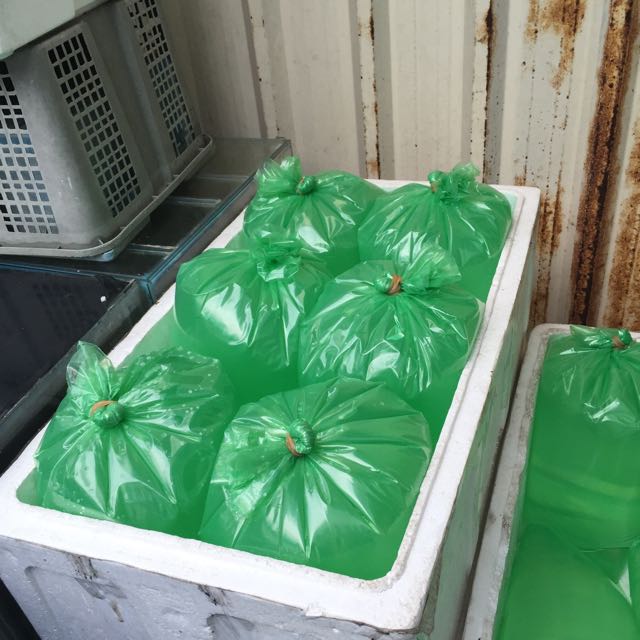
Seawater pack into 10L bag from Ah Beng Aquarium
Natural Sea Water (NSW) as the name applies, is collected naturally from the sea. usually, it involved a special vehicle that collected the seawater from one of the remote places of our shore and transported to the Live fish shop. As the natural seawater is dirty and could contain dirt, some form of preparation and filtration is required before it is put up for sales. The Live Fish Shop (LFS) will usually filter the raw seawater before selling it to you to make sure that the water is clean and to prevent unwanted organisms that might come along. MOST LFS will usally do a simple form of treatment and filtration themself which usually involves running the seawater through small micron filter sock , ozone and UV to sterlise the water before use.
Now let us break down to the Pros and Cons for easier understanding.
Pros
- Natural Seawater (NSW) is “cycled” and ready to be used completely, as it usually contains live beneficial bacteria from the sea. However, if you’re setting up a new tank, the live bacteria that contain in the natural seawater will greatly help speed up the cycling time of your new tank.
- You’re not required to put anti-chlorine for NSW (Never trust tap water, you never know what it contains) or use RO water to mix because it is already ready to be used right away.
- It is cheaper to purchase as compared to buying salt mix. All you need is to purchase the NSW and use it.
- It is simple and easy to use- No messy mixing of salt water or RODI filter required to prepare your water for saltmix.
Cons
- If you are intending to store your NSW for future way, It required circulation else the live bacteria might die and this method could take up space as well to store it before use.
- The parameter of NSW is not stable, as the salinity will vary between season and weather. Especially when collecting the seawater after a heavy rain, the salinity will definitely decrease. Our local Natural seawater range from 1.019 to 1.023, so topping up of salt is necessary to bring it up to the ideal level..
- Naturally, a lower salinity could also mean lower parameters like low calcium, KH , mg etc… Which required topping up of these elements as well for a reef tank.
- Although there might be some form of filtration carry out, there’s might still be a chance of parasite being introduce into the system if you are using NSW as it is not 100% filtered due to the large volume they handle.
- Logistic wise, delivering NSW is a nightmare as just to imagine having to carry 10 bags of NSW back home for a major water change, so, all in all, it might not be cheap after all.
- If you’re keeping a ratio of corals that depleting your elements faster than you replenish the elements, using seawater that has a lower parameter might result in your corals depriving the corals of elements example (CA, MG, KH). Which means you need to dose more of these elements, which add more cost to it as well.
- unlike using a salt mix , If you are using NSW, you will not be able to know the water parameter of your batch of NSW that you are using, unless you tested it, and bare in mind each batch of NSW that you use the parameter might be different.
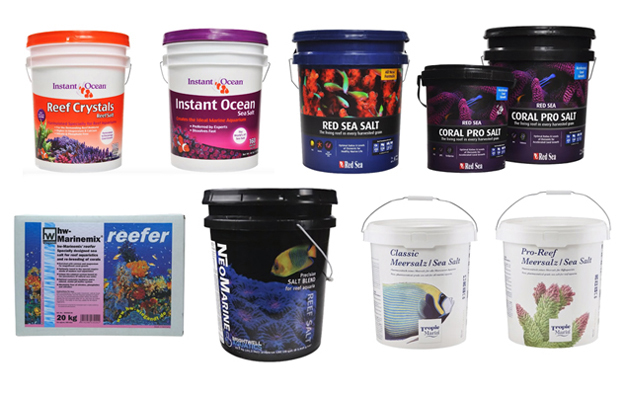
Various brand of saltmix ( ref; bulkreefsupply ) Now let’s talk about salt mix.
Video on how salt mix are produced.
The term salt mix simply means using aquarium salt to mix with your freshwater to produce synthetic saltwater that is suitable for both marine fish and corals. (Most of the time, we would recommend using a RODI filter to produce pure water which is free from any harmful impurities or substances which is often measured by TDS level. This would avoid adding any unknown source of the chemical into the salt mix that you are preapring.
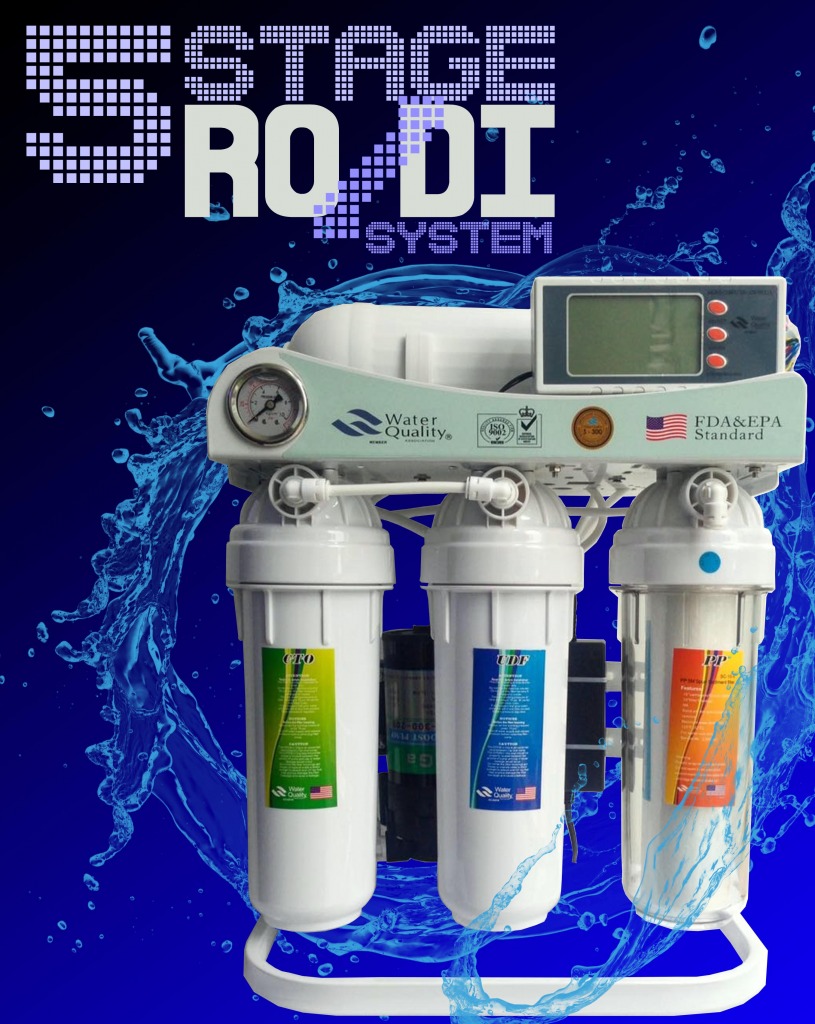
A typical 5 stage RO/DI water filter *Total dissolved solids (TDS) is the term used to describe the inorganic salts and small amounts of organic matter present in solution in water.
There are many various selling brands of salt mix available in the market, however, the prices of the salt vary from the country of origin, brands, parameters and weight of it.
Here’s the Procs and Cons of using Salt mix.
Pros
- Control level of trace elements that you know what you are adding into your tank.
- No unwanted parasite
- Easier to store as you only need to take out and mix when needed.
- No expiry date – Generally salt mix can be store for a long period of time without getting bad.
- Might be cheaper comparing to NSW to produce more saltwater vs weight.
Cons
- Need to mix and wait for the salt mix to be fully dissolved before use. BE PATIENT
- Need to dose bacteria especially when using it on a newly setup tank. However, some new brand of saltmix come with bacteria in it as well.
- Relatively expensive for small water volume change. (Unless you are buying in bulk)
- Require you to invest in a RO/DI water filter unit for your saltmix.
To learn how to use salt mix with RO water, check the video below!
That is it for today’s articles. Both have its advantage and disadvantage but it all depends on what kind of system do you want to run in. If you are interested to know any topic feel free to let me know!
If you want a clean and stable parameter every time you do a water change, Salt Mix could be the best option for you!
To understand more about reef chemistry and how it affects our reef tank, you may read more about this article here.
Conclusion
If you want to establish your new tank fast or if you want to do a major water change without requiring the time to stabile the parameter, then you can consider using NSW since it comes with bacteria. However, if you are doing a water change to replenish your existing tank water parameter or if you are concern about the safety of the water then using a salt mix might be a safer option to go for.
Author - @Willy Guccivera Yap
-
Singapore reefing community has evolved over the years, with more and more sophisticated setups, greater access to reef keeping information, wider variety of livestocks and many dedicated Reefers/LFS.
SRC has seen many successful local reef and FOWLR tanks and this thread seeks to collate photos and videos of the tanks within our community! A one stop thread for anyone to drool!
Hence, we would like to invite all Singapore Reefers, to actively contribute, to this thread, your full tank shots, macro shots of your display tank and videos of your vibrant marine life at home! For those with a great setup to share, photos of your live support system, controller consoles will be welcomed too!
To showcase the pride of our community, we will also be featuring these photos/videos, regularly, on various SRC social media platforms. (By sharing your shots on this thread, you would have also consented to the use of your media for the above purpose)
For each of your post, do upload your media and include your Instagram/Facebook account so that we provide credits when we feature your media on our social media platforms. Feel free to also tell us a little about your photo/video in your post, e.g. the species of the livestock(s), interesting facts about your setup or even a story of your tank.
Looking forward to your posts!
Who knows, your sharing here in this thread could lead to the bragging rights of the TOTQ titles

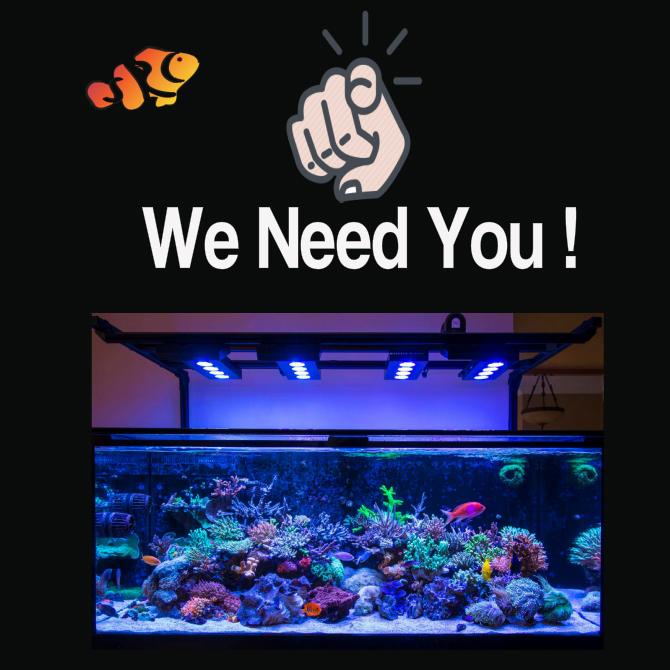
-
 4
4
-
-
Reefers will be spoil for more choices of corals, and congrat to the newly opened coral fanatics and supporting our community.
Coral Fanatics is started by a team of passionate reefers that turned purveyors of beautiful, and exotic rare corals. Looking forward to them bringing in more rare and special corals for our reefers here !
Coral Fanatics also specialises in in-house aquaculture of coral. Rare strains are preserved by propagation and made hardy for your home aquariums.
Stay tune to their shipment updates.
Contact Detail;
Email ; coralfanaticssg@gmail.com
Phone ; 8857 2044
Address; 160 Changi Rd, Singapore 419728, Hexacube
Facebook ; https://www.facebook.com/Coralfanatics-SG-106409094451977
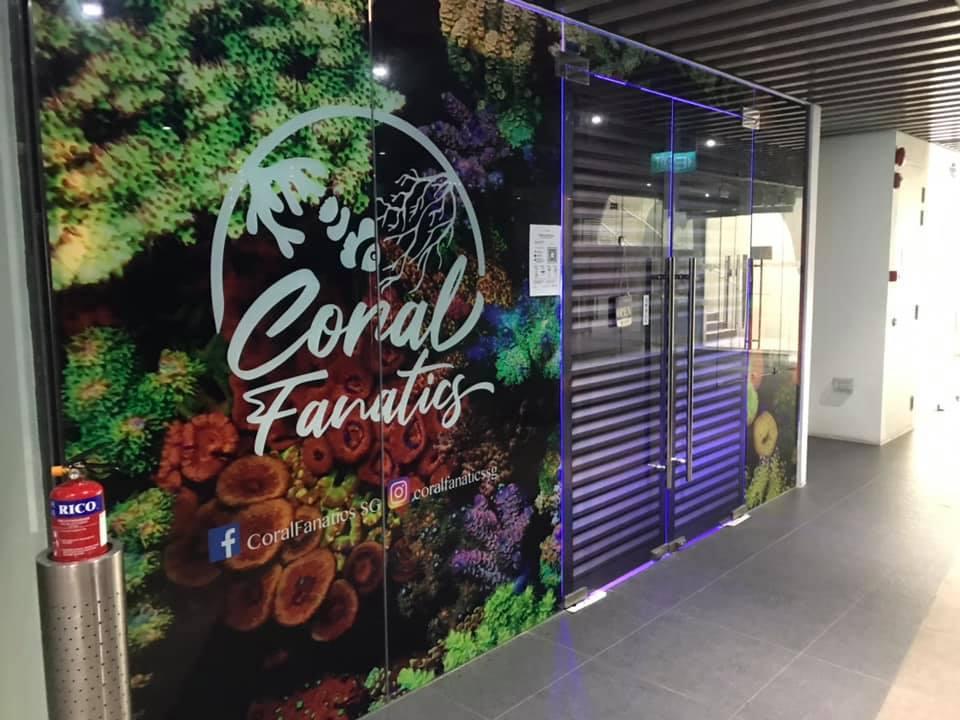
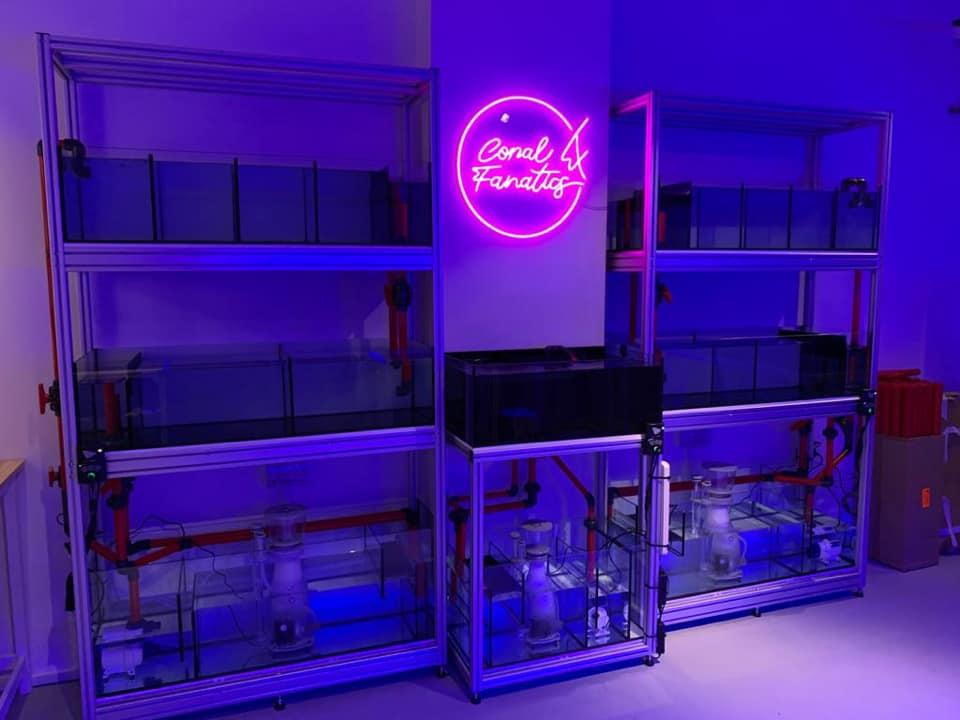
-
Hi,
Please state price for the sales under the pasa malam rules
-
Yes, please bare with us here , while they are fixing it..
-
Dear Members,
It has come to our attention from the authority that there has been a few members receiving official warning from our local authority regarding the excessive sales of live corals in the community going beyond as a hobbyist letting go overgrowth frags to becoming a part time coral seller in the community . Please note that the pasar malam section is mean for members to offload excess or overgrowth coral frags only. As such with effect on 03th Sept 2020,
- Sales of coral , frags is limited to Max 5 per week per member, please start a new topic once the limits is reach, all unsold coral/ frags has to be posted on the new week.
- Seller must publish price openly on their sales thread on their items for sales.
- For Tank Decom sales, it has to be stated clearly that you are selling away all the live stock due to a tank decommission.
- Thread which is deem to be a commercial listing by us will be removed without prior notification.
- Only related reefing equipment, tank sets and livestock is allowed.
- Please consider having your coral swap with other fellow members under our swap section.
- Link to other third party sales that display your items for sales is not allowed; i.e ebay. Gumtree, carousell, facebook, ect..
- To protect your privacy, members are strongly advise against sharing your contact no openly.Please use the PM instead for buyer to contact you .
- Thread found on violation of the above rules, will have his topic remove without any warning.
- Repeated offenders might find his posting rights temporary disabled and repeated offenders might have his posting right permanently disabled in this forum.We would like like to bring to your attention from the NPARK authority that Under the Singapore animals and birds act ( Pet Shop And exhibition) Rules 2004, it is an offence to use any premised to keep and display animals intended for sales as pet without a pet licence, except in accordance with a valid licence issued by the Director General. Sales without a pet shop license is a prosecutable offence, which carry a fine and imprisoned .
https://sso.agc.gov.sg/SL-Supp/S34-2004/Published/20040930?DocDate=20040127
Thank you and we seek your co-operation in this manner
-
 4
4
-
-
Welcome our Singapore;'s friendly local fish store - Ah beng aquarium to support our community .

Located in the central part of the Singapore, and with a regular weekly fish shipment from all over the world. They are the place to go for both dry goods and live stocks .
There contact ;
Ah Beng Aquarium
471 Geylang Rd, Singapore 389430
Phone: 9776 1341
https://goo.gl/maps/x4obxxenanXbeut39Facebook ; https://www.facebook.com/ahbeng.aquarium
-
Latest update of Singapore marine Live fish store (24.08.2020 )
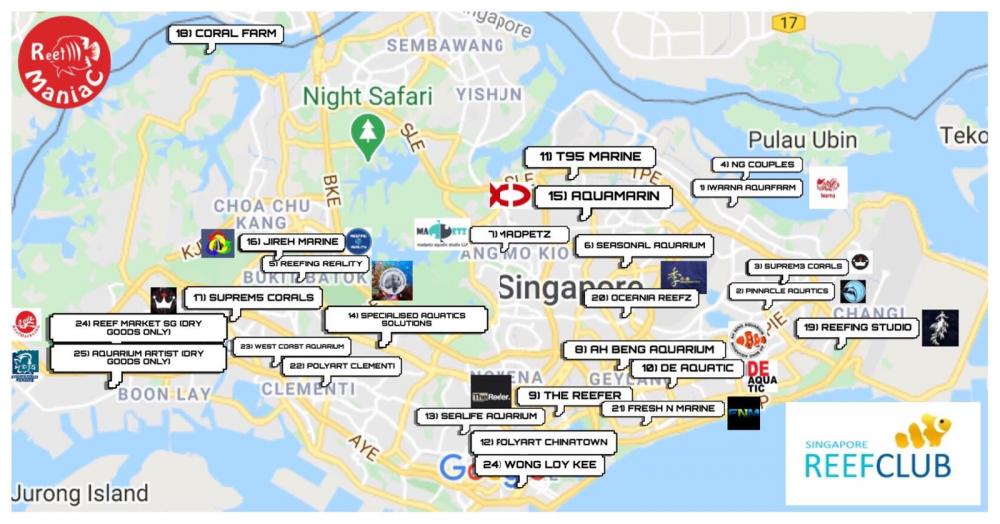
1. IWARNA AQUAFARM
Location:
Aquarium Iwarna Pte Ltdn
70 Pasir Ris Farmway 3, Singapore 518234
https://goo.gl/maps/CX6FAyS6vNVmXg7G82. PINNACLE AQUATICS
Location:
164 Tampines Street 12, #01-291, Singapore 521164
6386 0060
https://goo.gl/maps/458F4mGtZoy6XQ7B73. SUPREM3 CORALS
Location:
264 Tampines Street 21, Singapore 520264
https://goo.gl/maps/nbYjUvSLfXRVmfc484. C2 MARINE (NG COUPLES)
Location:
1 Pasir Ris Coast Industrial Park 1 Singapore 518235
Tel: +65 9639 5355
https://goo.gl/maps/saT29QSwTrGzF7VB95. REEFING REALITY
Location:
17 Dairy Farm Rd, Singapore 679043
9325 8321
https://goo.gl/maps/mQdkwUPB7fJmkpQi86. SEASONAL AQUARIUM
Location:
192 Yio Chu Kang Rd, Singapore 545639
9385 4760
https://goo.gl/maps/dgZJtvgcrnmyPEcZ87. MADPETZ
Location:
128 Ang Mo Kio Ave 3, #01-1867, Singapore 560128
6456 6330
https://goo.gl/maps/XwRVRSqGSdSmph5x68. AH BENG AQUARIUM
Location:
471 Geylang Rd, Singapore 389430
9776 1341
https://goo.gl/maps/sQrtuaMV2Ypg98eR99. THE REEFER
Location:
Blk 463 Crawford Ln, #01-07, Singapore 190463
https://goo.gl/maps/6j7bnv7S1NH3b3Fp710. DE AQUATIC
Location:
706 Geylang Rd, Singapore 389621
6741 4080
https://goo.gl/maps/Ju6xwxYdYFWdbgxc911. T95 MARINE
Location:
27 Seletar West Farmway 1, Singapore 798127
https://goo.gl/maps/Gxb66egMZz5TBYLi912. POLYART CHINATOWN
Location:
Block 4 Sago Ln, 01-127, Singapore 050004
6327 0028
https://goo.gl/maps/ptZDe1gqx3Ah7qkH713. SEALIFE AQUARIUM
Location:
78 Indus Rd, Block 78, Singapore 161078
https://goo.gl/maps/q5ZyMq6LLECAuzYs514. SPECIALISED AQUATICS SOLUTIONS
Location:
19 Anamalai Ave, Singapore 279987
6314 3808
https://goo.gl/maps/r1Mnm4qVaf75o9qy915. AQUAMARIN
Location:
32 Jln Selaseh, Singapore 808448
6383 7277
https://goo.gl/maps/ozmDsJwZsTKMeiyK616. JIREN MARINE
Location:
61 Jln Lekar, Singapore 698948
9623 6644
https://goo.gl/maps/JY9WLEKuZPrkcC9E817. SUPREM5 CORALS
Location:
Jurong East Street 13, #01-402 Block 114, Singapore 600114
https://goo.gl/maps/cvNvtx8ps7RiJPXSA18. CORAL FARM
Location:
5 Lim Chu Kang Lane 6D, Singapore 719766
https://goo.gl/maps/cvV92zHwMBcvDSmTA19. REEFING STUDIO
Location:
Blk 1 Changi Village Road #01, 2010A, 500001
8893 0176
https://goo.gl/maps/XFGhxpLioZH7zu6o920. OCEANIA REEFZ
Location:
181 Upper Paya Lebar Rd, Singapore 534866
9846 2807
https://goo.gl/maps/rsW6Qb1qDAqu8wPcA21. FRESH N MARINE
Location:
79 Upper East Coast Rd, Singapore 455219
6547 1575
https://goo.gl/maps/4pricQFXTkLPX4nS922. POLYART CLEMENTI
Location:
Clementi Ave 2, #01-194 Block 328, Singapore 120328
6775 4773
https://goo.gl/maps/zdaM7cVAVvpz1jFa723. WEST COAST AQUARIUM
Location:
BLK 502 #01-25 WEST COAST DRIVE
SINGAPORE 120502
https://goo.gl/maps/UvDvR5i33RXXn1FK724. WONG LOY KEE
Location:
Sago Ln, 4号#02-119 邮政编码: 050004
6222 9763
https://goo.gl/maps/xn4tnDZhuB8nZ3VF624. ReefMarketSg ( Dry Goods only )
Location:
1 Sunview Road #03-30 Eco-tech@Sunview S(627615)
By Appointment Only*
Online Shop:
https://reefmarketsg.com.sg
https://goo.gl/maps/rq5F1JdxRmtSpqqA8 l25. Aquarium Artist ( Dry Goods Only)
Location:
1 Sunview Road #08-37 Eco-tech@Sunview S(627615)
By Appointment Only*
Online Shop:
https://aquariumartist.com.sg
https://goo.gl/maps/YeNjaLdBxk7P42Ys7-
 6
6
-
-
12 hours ago, quam said:
Hi, I'm interested in having 2 packs (promo). Can sent a grab for pick up tomorrow? Thank you
Sent from Singapore Reef Club mobile app
think you PM or whatsapp them directly for faster respond ( 8845 5555 )
-
Since the government announcement of phase 2, and sales of live stock is now allowed.
-
36 minutes ago, LittleNat1 said:
I think the list has a mistake
 . My username repeated for no.5 and no.34.
. My username repeated for no.5 and no.34.
Sent from Singapore Reef Club mobile app
ah Yes thanks for pointing out the error.. Already edited the sequence .
-
Congratulation to all the winners !
Prizes by Value ( Highest to Lowest )
1) AI 64 HD LED x 1
2) Clarisea SK5000 roller filter x 1
3) SPS Mystery pack ( 5 frags Worth $500 )
4) Zoas Mystery pack (5 frags Worth $500)
5 ) Fauna Marin Balling set x 1
6) HARDCOREREEFER magnetic frag station petite x 1
7) Coral RX Industrial x 1
8) Coral RX Pro x 1
9 to 11 ) Vitalis Mini Marine Glazer 110g
12 to 16 ) Viatlis Algae pellet XS 60g
17 to 26) Coral RX Single Shot coral Dip
27 to 36 ) DD Coral Glass37 to 42 ) Glue Onz coral Glue
Winning List ( First to Last after removing duplicated name list )1) Darren Sim
2) soggycookies
3) RayTCZ
4) SubzeroLT
5) LittleNat1
6) MarCal
7) danano
8) victorchantm
9) Law88
10) Teck pang
11) Admiraltian
12) nuclear_fibre
13) R0B
14) Nick Ang
15) David
16) ZmasonJ
17) SaltySpivia
18) Clement Chen
19) yakh0o
20) Snoopyhamburger
21) Sherilyn91
22) brannonong
23) C.ZhengXi
24) jem
25) Patrick
26) Chronos
27) titustitus
28) josephwzr
29) chocolate98
30) pcw
31) reefercoral
32) zander
33) Daniel Poh Yang Zheng
34) milu_kaka
35) noobzpro
36) nico
37) nec
38) clementesia
39) CarnivorousGhecko
40) acodestny
41) teck4300
42) alvarogr-
 4
4
-
-
try checking with fresh n marine on this.. they are the agent for kessil here
-
Hi guys,
Thanks for the participation, will be organizing the draw and update shortly..
Stay Tune !
-
 2
2
-
-
Dear Members,
we have been notified by authority that ALL LIVE STOCK SALES / TRADING in the forum is still prohibited during this Post CB phase one , following all local LFS / Pet Shop directive set forward.
Thus temporary all live stocks ( Corals /Fishes ) is NOT Allowed in the pasa malam section.
Thank you for your co-operation.
** All live stocks related post (Sale/Request) will be automatically remove during this period without notice **
-
Dear Members,
we have been notified by authority that ALL LIVE STOCK SALES is still prohibited during this CB phase one , following all local LFS / Pet Shop directive set forward.
Thus temporary all live stocks ( Corals /Fishes ) is NOT Allowed in the pasa malam section.
Thank you for your co-operaton.
** All live stock related will be automatically remove during this period without notice **
-
Dear Members,
As we embark on phase one of the CB period, we advise that all sales should be conducted contactless or engage a third party for delivery to protect yourself and others.Stay Safe and united.. Hopefully this pandemic will soon pass !
#sgreefclub
-
 1
1
-
-
-
Sharing some of the inspiring reef tank video setup

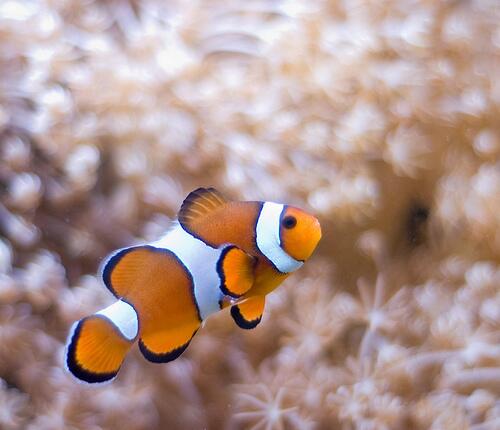

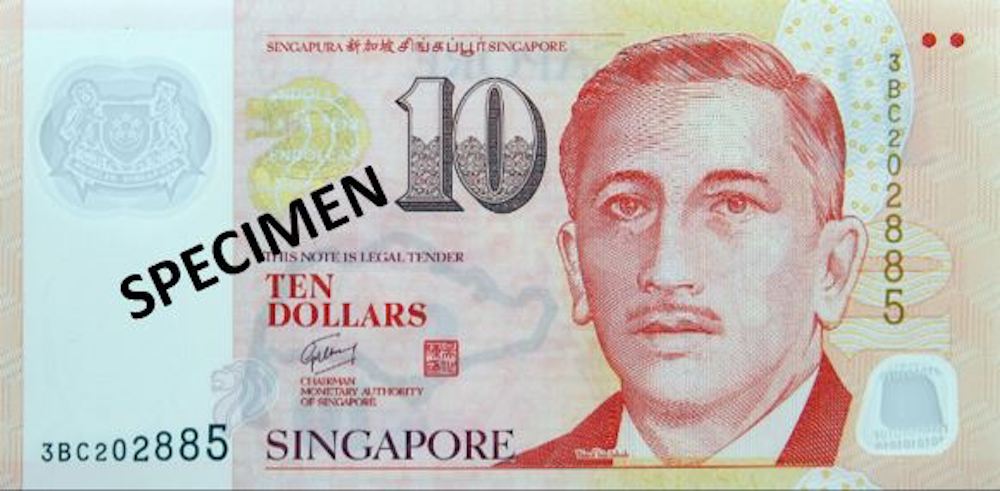

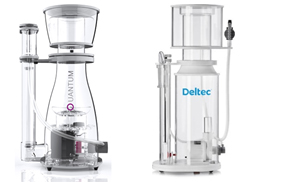
[DISCUSSION] Behind the scene of coral importation EP:1 (How do we get our corals)
in SRC Reefing Article
Posted
Behind the scene of coral importation EP:1 (How do we get our corals)
As a hobbyist, we might always be wondering where and how coral is collected and imported into Singapore, landed in one of the local live fish shop (LFS) before it eventually ended up in our fish tank.
We would like to take this opportunity to thanks coral fanatic that is willing to share with us the insight of the whole importation process , so we as the hobbyist can start to appreciate the work behind it.
Beginning – Source of the corals
Corals are protected by international CITES regulation against over-exploitation through international trade, and ONLY cultured corals or species that are deemed non-impact to the environment or post any threat of extinction are allowed to be collected.
Indonesia is one of the major exporters of coral for the aquarium trade which make up of almost 71% of market share. Most of the corals found in the aquarium trade are either from the coral triangle or from Australi , Fiji and Hawaii etc..
Importation of corals
Shipping Corals are sensitive to temperature so shipping by air is the only possible way.
As spoken eariler, hard corals such as LPS and SPS are heavily protected under the Convention for International Trade in Endangered Species (CITES). Before a shipment can be arranged, the local Live Fish Shop will need to verify that all corals which are going to be imported come with a legal cities certificate, which is like a birth certificate of the corals which could indicate details such as genus, species sciencic name, name of the coral farm, location harvested ect..
This will follow up with the application of an import CITES permit application with our local governing authority NParks board. The process for approval could takes anywhere between two to four weeks before the import permit application is approved for import. Only upon approval, the LFS can arrange for a shipment date with the exporter to arrange for the shipment to be flown in .
Once these details are finalized and freight space is confirmed, the exporter packs the shipment according to what was declared on the CITES and order. Upon shipment arrival in Singapore, this is when the race against time actually start! As corals has to be cleared from custom and bring back to the shop at the shortest possible time to protect the health/quality of the corals and toavoid any causality of the corals. The usual process usually involves the logistics staff/company that will collect and clear the cargo and bringing it for further cargo clearance inspection. However, in this particular instance, the staff from Coral Fanatics actually collected and cleared their shipment themselves to ensure that their coral is clear and arrived at the shortest possible time! Kudos to them for that !!
Coral are carefully packed and labelled during shipment
How many boxes can you see? How much coral do you think it contains in one box? Make a guess!
NParks Qurantine station.
The boxes are then transported to Changi Animal and Plant Quarantine (CAPQ) for inspection by NParks authorities to ensure that the species, genus and quantity imported are in accordance to what was cleared in the CITES import and export permit, before releasing the cargo to the consignee.
Boxes of corals ready to be transported back for unpacking
There is usually a minimum quantity set aside by the exporter of the corals, so it is almost impossible for the individual hobbyist to import it themselves taking into consideration, the space required to hold and keep the corals. And not forgetting the risk involved one has to undertake in the even that corals are death when you open it up, just image after going through all the tedious and expensive importation process that one has to go through and find out that corals are all DOA ( Death Upon Arrival ). So coral packaging is extremely important to ensure that all corals will arrive safely and healthy.
Shipment arrived at Coral Fanatics
And now the shipment arrived at the shop, and this is only when the hard work starts! As corals are shipped in a limited amount of water, it has to be removed and transfer to better quality water in the shortest possible time to avoid any casualty.
Upon removal of all the corals from the packaging boxes, visual inspection as well as a simple coral dip and acclimatize process is carry out to ensure that all corals are healthy and pest free before releasing it into their display tank .
Check out the color of these coral before it even put into the tank
Corals that arrived are usually left to settle down for up to 48 hour to check for any sign for stress or any un-healthy parts are removed or trim to protect those that are still healthy before finally releasing it for sales.
Healthy coral that arrived safely usually start displaying healthy polyps and colors
Once the corals are settled down, corals will be available for sales to the hobbyist and remember to do you own coral acclimatize and coral dipping and quarantine progress as well, as it is not 100% as eggs could be present in these wild colony.
Want to be the first to know when is the next coral shipment from coral fanatics? Do remember to check out their section in the forum or their coral fanatics telegram group or else subscribe to our SRC broadcast telegram group which we update shipment of all various LFS in Singapore. And lastly don’t forget to contact them to reserve your favourite pcs of corals if you happen to see it as every pcs of corals that were imported is unique and chances are you might not see either the exact same species, colouration, or similar size anymore!
So that is all for BEHIND THE SCENE EP:1 (How do we get our corals) and stay tuned for the next episode that is coming soon!
Author - @Willy Guccivera Yap